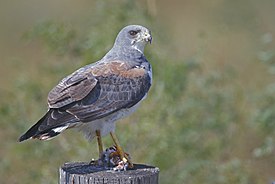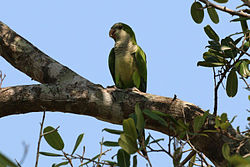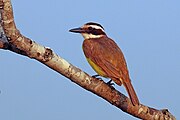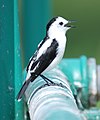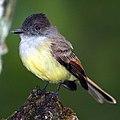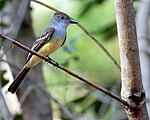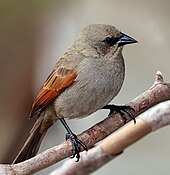bio.wikisort.org - Animal
Brazil has one of the richest bird diversities in the world. The avifauna of Brazil include a total of 1858 confirmed species of which 238 are endemic. Five have been introduced by humans, 96 are rare or vagrants, and five are extinct or extirpated. An additional 14 species are hypothetical (see below).

Brazil hosts about 60% of the bird species recorded for all of South America. These numbers are still increasing almost every year, due to new occurrences, new species being described, or splits of existing species. About 10% of the bird species found in Brazil are, nonetheless, threatened.
In June 2013 a simultaneous discovery of fifteen bird species in Brazil was announced, the first such since 1871, when August von Pelzeln described forty new species.[1] The birds were from the families Corvidae, Thamnophilidae, Dendrocolaptidae, Tyrannidae, and Polioptilidae.[2] Eleven of the new species are endemics of Brazil and four also inhabit Peru and Bolivia.[1]
Except as an entry is cited otherwise, the list of species is that of the South American Classification Committee (SACC) of the American Ornithological Society.[3][4] The list's taxonomic treatment (designation and sequence of orders, families, and species) and nomenclature (common and scientific names) are also those of the SACC.[5] Two additional species are added from other sources and are not included in the above counts.
The notes of population status, for instance (endangered), are those of the International Union for Conservation of Nature (IUCN) Red List.[6] The status notes apply to the worldwide population, not solely the Brazilian population except for endemic species.
The following tags have been used to highlight several categories of occurrence.
- (V) Vagrant - a species that rarely or accidentally occurs in Brazil
- (E) Endemic - a species endemic to Brazil
- (I) Introduced - a species introduced to Brazil as a consequence, direct or indirect, of human actions
- (H) Hypothetical - a species recorded but with "no tangible evidence" according to the SACC
Rheas
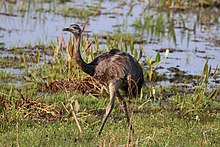
Order: Rheiformes Family: Rheidae
The rheas are large flightless birds native to South America. Their feet have three toes rather than four which allows them to run faster.
- Greater rhea, Rhea americana (near-threatened)
Tinamous
Order: Tinamiformes Family: Tinamidae


The tinamous are one of the most ancient groups of bird. Although they look similar to other ground-dwelling birds like quail and grouse, they have no close relatives and are classified as a single family, Tinamidae, within their own order, the Tinamiformes. They are distantly related to the ratites (order Struthioniformes), which includes the rheas, emus, and kiwis.
- Gray tinamou, Tinamus tao
- Solitary tinamou, Tinamus solitarius (near-threatened)
- Great tinamou, Tinamus major
- White-throated tinamou, Tinamus guttatus
- Cinereous tinamou, Crypturellus cinereus
- Little tinamou, Crypturellus soui
- Brown tinamou, Crypturellus obsoletus
- Undulated tinamou, Crypturellus undulatus
- Brazilian tinamou, Crypturellus strigulosus
- Gray-legged tinamou, Crypturellus duidae
- Red-legged tinamou, Crypturellus erythropus
- Yellow-legged tinamou, Crypturellus noctivagus (E) (near-threatened)
- Black-capped tinamou, Crypturellus atrocapillus
- Variegated tinamou, Crypturellus variegatus
- Rusty tinamou, Crypturellus brevirostris
- Bartlett's tinamou, Crypturellus bartletti
- Small-billed tinamou, Crypturellus parvirostris
- Tataupa tinamou, Crypturellus tataupa
- Red-winged tinamou, Rhynchotus rufescens
- White-bellied nothura, Nothura boraquira
- Lesser nothura, Nothura minor (vulnerable)
- Spotted nothura, Nothura maculosa
- Dwarf tinamou, Taoniscus nanus (vulnerable)
Screamers

Order: Anseriformes Family: Anhimidae
The screamers are a small family of birds related to the ducks. They are large, bulky birds, with a small downy head, long legs, and large feet which are only partially webbed. They have large spurs on their wings which are used in fights over mates and in territorial disputes.
- Horned screamer, Anhima cornuta
- Southern screamer, Chauna torquata
Ducks
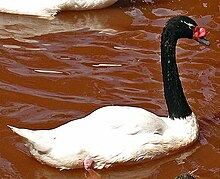

Order: Anseriformes Family: Anatidae
Anatidae includes the ducks and most duck-like waterfowl, such as geese and swans. These birds are adapted to an aquatic existence with webbed feet, flattened bills, and feathers that are excellent at shedding water due to an oily coating.
- Fulvous whistling-duck, Dendrocygna bicolor
- White-faced whistling-duck, Dendrocygna viduata
- Black-bellied whistling-duck, Dendrocygna autumnalis
- Black-necked swan, Cygnus melancoryphus
- Coscoroba swan, Coscoroba coscoroba
- Orinoco goose, Oressochen jubatus (near-threatened)
- Upland goose, Chloephaga pictus (V)
- Muscovy duck, Cairina moschata
- Comb duck, Sarkidiornis sylvicola
- Ringed teal, Callonetta leucophrys
- Brazilian teal, Amazonetta brasiliensis
- Silver teal, Spatula versicolor
- Red shoveler, Spatula platalea
- Blue-winged teal, Spatula discors (V)
- Cinnamon teal, Spatula cyanoptera (V)
- Chiloe wigeon, Mareca sibilatrix
- White-cheeked pintail, Anas bahamensis
- Northern pintail, Anas acuta (V)
- Yellow-billed pintail, Anas georgica
- Yellow-billed teal, Anas flavirostris
- Southern pochard, Netta erythrophthalma
- Rosy-billed pochard, Netta peposaca
- Brazilian merganser, Mergus octosetaceus (critically endangered)
- Black-headed duck, Heteronetta atricapilla
- Masked duck, Nomonyx dominicus
- Lake duck, Oxyura vittata
Guans
Order: Galliformes Family: Cracidae
The Cracidae are large birds, similar in general appearance to turkeys. The guans and curassows live in trees, but the smaller chachalacas are found in more open scrubby habitats. They are generally dull-plumaged, but the curassows and some guans have colorful facial ornaments.
- Marail guan, Penelope marail
- Rusty-margined guan, Penelope superciliaris
- Spix's guan, Penelope jacquacu
- Dusky-legged guan, Penelope obscura
- White-crested guan, Penelope pileata (E) (vulnerable)
- Chestnut-bellied guan, Penelope ochrogaster (E) (vulnerable)
- White-browed guan, Penelope jacucaca (E) (vulnerable)
- Blue-throated piping-guan, Pipile cumanensis
- Red-throated piping-guan, Pipile cujubi
- Black-fronted piping-guan, Pipile jacutinga (vulnerable)
- Chaco chachalaca, Ortalis canicollis
- Speckled chachalaca, Ortalis guttata
- East Brazilian chachalaca, Ortalis araucuan (E)
- Scaled chachalaca, Ortalis squamata (E)
- Variable chachalaca, Ortalis motmot
- Chestnut-headed chachalaca, Ortalis ruficeps (E)
- Buff-browed chachalaca, Ortalis superciliaris (E)
- Nocturnal curassow, Nothocrax urumutum
- Black curassow, Crax alector
- Wattled curassow, Crax globulosa (vulnerable)
- Bare-faced curassow, Crax fasciolata
- Red-billed curassow, Crax blumenbachii (E) (endangered)
- Crestless curassow, Mitu tomentosum
- Razor-billed curassow, Mitu tuberosum
- Alagoas curassow, Mitu mitu (E) (extinct in the wild)
- Dusky-legged guan
- Chaco chachalaca
- Bare-faced curassow
New World quails
Order: Galliformes Family: Odontophoridae
The New World quails are small, plump terrestrial birds only distantly related to the quails of the Old World, but named for their similar appearance and habits.
- Crested bobwhite, Colinus cristatus
- Marbled wood-quail, Odontophorus gujanensis
- Spot-winged wood-quail, Odontophorus capueira
- Starred wood-quail, Odontophorus stellatus
Flamingos

Order: Phoenicopteriformes Family: Phoenicopteridae
Flamingos are gregarious wading birds, usually 3 to 5 feet (0.9 to 1.5 m) tall, found in both the Western and Eastern Hemispheres. Flamingos filter-feed on shellfish and algae. Their oddly shaped beaks are specially adapted to separate mud and silt from the food they consume and, uniquely, are used upside-down.
- Chilean flamingo, Phoenicopterus chilensis (near-threatened)
- American flamingo, Phoenicopterus ruber
- Andean flamingo, Phoenicoparrus andinus (V)
- James's flamingo, Phoenicoparrus jamesi (V)
Grebes

Order: Podicipediformes Family: Podicipedidae
Grebes are small to medium-large freshwater diving birds. They have lobed toes and are excellent swimmers and divers. However, they have their feet placed far back on the body, making them quite ungainly on land.
- White-tufted grebe, Rollandia rolland
- Least grebe, Tachybaptus dominicus
- Pied-billed grebe, Podilymbus podiceps
- Great grebe, Podiceps major
- Silvery grebe, Podiceps occipitalis
Pigeons
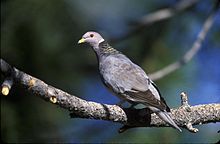

Order: Columbiformes Family: Columbidae
Pigeons and doves are stout-bodied birds with short necks and short slender bills with a fleshy cere.
- Rock pigeon, Columba livia (I)
- Scaled pigeon, Patagioenas speciosa
- Picazuro pigeon, Patagioenas picazuro
- Spot-winged pigeon, Patagioenas maculosa
- Band-tailed pigeon, Patagioenas fasciata
- Pale-vented pigeon, Patagioenas cayennensis
- Plumbeous pigeon, Patagioenas plumbea
- Ruddy pigeon, Patagioenas subvinacea
- Sapphire quail-dove, Geotrygon saphirina
- Ruddy quail-dove, Geotrygon montana
- Violaceous quail-dove, Geotrygon violacea
- White-tipped dove, Leptotila verreauxi
- Gray-fronted dove, Leptotila rufaxilla
- Eared dove, Zenaida auriculata
- Blue ground dove, Claravis pretiosa
- Long-tailed ground dove, Uropelia campestris
- Purple-winged ground dove, Paraclaravis geoffroyi (critically endangered)
- Common ground dove, Columbina passerina
- Plain-breasted ground dove, Columbina minuta
- Ruddy ground dove, Columbina talpacoti
- Scaled dove, Columbina squammata
- Picui ground dove, Columbina picui
- Blue-eyed ground dove, Columbina cyanopis (E) (critically endangered)
Cuckoos
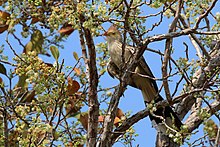
Order: Cuculiformes Family: Cuculidae
The family Cuculidae includes cuckoos, roadrunners, and anis. These birds are of variable size with slender bodies, long tails and strong legs.
- Guira cuckoo, Guira guira
- Greater ani, Crotophaga major
- Smooth-billed ani, Crotophaga ani
- Striped cuckoo, Tapera naevia
- Pheasant cuckoo, Dromococcyx phasianellus
- Pavonine cuckoo, Dromococcyx pavoninus
- Rufous-vented ground-cuckoo, Neomorphus geoffroyi
- Scaled ground-cuckoo, Neomorphus squamiger (E) (vulnerable)
- Rufous-winged ground-cuckoo, Neomorphus rufipennis
- Red-billed ground-cuckoo, Neomorphus pucheranii
- Little cuckoo, Coccycua minuta
- Dwarf cuckoo, Coccycua pumila (H)
- Ash-colored cuckoo, Coccycua cinerea
- Squirrel cuckoo, Piaya cayana
- Black-bellied cuckoo, Piaya melanogaster
- Dark-billed cuckoo, Coccyzus melacoryphus
- Yellow-billed cuckoo, Coccyzus americanus
- Pearly-breasted cuckoo, Coccyzus euleri
- Mangrove cuckoo, Coccyzus minor
- Black-billed cuckoo, Coccyzus erythropthalmus (V)
- Common cuckoo, Cuculus canorus (V)
Oilbird
Order: Steatornithiformes Family: Steatornithidae
The oilbird is a slim, long-winged bird related to the nightjars. It is nocturnal and a specialist feeder on the fruit of the oil palm.
- Oilbird, Steatornis caripensis
Potoos

Order: Nyctibiiformes Family: Nyctibiidae
The potoos (sometimes called poor-me-ones) are large near passerine birds related to the nightjars and frogmouths. They are nocturnal insectivores which lack the bristles around the mouth found in the true nightjars.
- Rufous potoo, Phyllaemulor bracteatus
- Great potoo, Nyctibius grandis
- Long-tailed potoo, Nyctibius aethereus
- Common potoo, Nyctibius griseus
- White-winged potoo, Nyctibius leucopterus
Nightjars


Order: Caprimulgiformes Family: Caprimulgidae
Nightjars are medium-sized nocturnal birds that usually nest on the ground. They have long wings, short legs, and very short bills. Most have small feet, of little use for walking, and long pointed wings. Their soft plumage is camouflaged to resemble bark or leaves.
- Nacunda nighthawk, Chordeiles nacunda
- Least nighthawk, Chordeiles pusillus
- Sand-colored nighthawk, Chordeiles rupestris
- Lesser nighthawk, Chordeiles acutipennis
- Common nighthawk, Chordeiles minor
- Antillean nighthawk, Chordeiles gundlachii (V)
- Short-tailed nighthawk, Lurocalis semitorquatus
- Band-tailed nighthawk, Nyctiprogne leucopyga (see note)[note 1]
- Bahian nighthawk, Nyctiprogne vielliardi (E)
- Blackish nightjar, Nyctipolus nigrescens
- Pygmy nightjar, Nyctipolus hirundinaceus (E)
- Band-winged nightjar, Systellura longirostris
- Common pauraque, Nyctidromus albicollis
- White-winged nightjar, Eleothreptus candicans (endangered)
- Sickle-winged nightjar, Eleothreptus anomalus (near-threatened)
- Todd's nightjar, Setopagis heterura
- Little nightjar, Setopagis parvula
- Roraiman nightjar, Setopagis whitelyi
- White-tailed nightjar, Hydropsalis cayennensis
- Spot-tailed nightjar, Hydropsalis maculicaudus
- Ladder-tailed nightjar, Hydropsalis climacocerca
- Scissor-tailed nightjar, Hydropsalis torquata
- Long-trained nightjar, Macropsalis forcipata
- Ocellated poorwill, Nyctiphrynus ocellatus
- Silky-tailed nightjar, Antrostous sericocaudatus
- Rufous nightjar, Antrostomus rufus
Swifts

Order: Apodiformes Family: Apodidae
Swifts are small birds which spend the majority of their lives flying. These birds have very short legs and never settle voluntarily on the ground, perching instead only on vertical surfaces. Many swifts have long swept-back wings which resemble a crescent or boomerang.
- White-chinned swift, Cypseloides cryptus
- Black swift, Cypseloides niger
- White-chested swift, Cypseloides lemosi (H)
- Sooty swift, Cypseloides fumigatus
- Great dusky swift, Cypseloides senex
- Tepui swift, Streptoprocne phelpsi
- White-collared swift, Streptoprocne zonaris
- Biscutate swift, Streptoprocne biscutata
- Gray-rumped swift, Chaetura cinereiventris
- Band-rumped swift, Chaetura spinicaudus
- Pale-rumped swift, Chaetura egregia
- Chimney swift, Chaetura pelagica
- Chapman's swift, Chaetura chapmani
- Sick's swift, Chaetura meridionalis
- Short-tailed swift, Chaetura brachyura
- White-tipped swift, Aeronautes montivagus
- Fork-tailed palm-swift, Tachornis squamata
- Lesser swallow-tailed swift, Panyptila cayennensis
Hummingbirds
Order: Apodiformes Family: Trochilidae
Hummingbirds are small birds capable of hovering in mid-air due to the rapid flapping of their wings. They are the only birds that can fly backwards.
- Crimson topaz, Topaza pella
- Fiery topaz, Topaza pyra
- White-necked jacobin, Florisuga mellivora
- Black jacobin, Florisuga fusca
- Saw-billed hermit, Ramphodon naevius (E) (near-threatened)
- Hook-billed hermit, Glaucis dohrnii (E) (endangered)
- Rufous-breasted hermit, Glaucis hirsutus
- Pale-tailed barbthroat, Threnetes leucurus
- Sooty barbthroat, Threnetes niger
- Broad-tipped hermit, Anopetia gounellei (E)
- Dusky-throated hermit, Phaethornis squalidus (E)
- Streak-throated hermit, Phaethornis rupurumii
- Tapajos hermit, Phaethornis aethopygus (E)
- Minute hermit, Phaethornis idaliae (E)
- Cinnamon-throated hermit, Phaethornis nattereri
- Gray-chinned hermit, Phaethornis griseogularis
- Reddish hermit, Phaethornis ruber
- Buff-bellied hermit, Phaethornis subochraceus
- Sooty-capped hermit, Phaethornis augusti
- Planalto hermit, Phaethornis pretrei
- Scale-throated hermit, Phaethornis eurynome
- White-bearded hermit, Phaethornis hispidus
- Needle-billed hermit, Phaethornis philippii
- Straight-billed hermit, Phaethornis bourcieri
- Long-tailed hermit, Phaethornis superciliosus
- Great-billed hermit, Phaethornis malaris
- Blue-fronted lancebill, Doryfera johannae
- Hyacinth visorbearer, Augastes scutatus (E) (near-threatened)
- Hooded visorbearer, Augastes lumachella (E) (near-threatened)
- Brown violetear, Colibri delphinae
- Sparkling violetear, Colibri coruscans
- White-vented violetear, Colibri serrirostris
- Horned sungem, Heliactin bilophus
- Black-eared fairy, Heliothryx auritus
- White-tailed goldenthroat, Polytmus guainumbi
- Green-tailed goldenthroat, Polytmus theresiae
- Fiery-tailed awlbill, Avocettula recurvirostris
- Ruby-topaz hummingbird, Chrysolampis mosquitus
- Green-throated mango, Anthracothorax viridigula
- Black-throated mango, Anthracothorax nigricollis
- Black-bellied thorntail, Discosura langsdorffi
- Racket-tailed thorntail, Discosura longicaudus
- Tufted coquette, Lophornis ornatus
- Dot-eared coquette, Lophornis gouldii
- Frilled coquette, Lophornis magnificus (E)
- Spangled coquette, Lophornis stictolophus
- Butterfly coquette, Lophornis verreauxii
- Festive coquette, Lophornis chalybeus
- Peacock coquette, Lophornis pavoninus
- Velvet-browed brilliant, Heliodoxa xanthogonys
- Black-throated brilliant, Heliodoxa schreibersii
- Gould's jewelfront, Heliodoxa aurescens
- Brazilian ruby, Heliodoxa rubricauda (E)
- Long-billed starthroat, Heliomaster longirostris
- Stripe-breasted starthroat, Heliomaster squamosus (E)
- Blue-tufted starthroat, Heliomaster furcifer
- Amethyst woodstar, Calliphlox amethystina
- Blue-tailed emerald, Chlorostilbon mellisugus
- Glittering-bellied emerald, Chlorostilbon lucidus
- Blue-chinned sapphire, Chlorestes notata
- Green-crowned plovercrest, Stephanoxis lalandi (E)
- Purple-crowned plovercrest, Stephanoxis loddigesii
- Gray-breasted sabrewing, Campylopterus largipennis
- Outcrop sabrewing, Campylopterus calcirupicola (E)
- Diamantina sabrewing, Campylopterus diamantinensis (E)
- Rufous-breasted sabrewing, Campylopterus hyperythrus
- Buff-breasted sabrewing, Campylopterus duidae
- Fork-tailed woodnymph, Thalurania furcata
- Long-tailed woodnymph, Thalurania watertonii (E)
- Violet-capped woodnymph, Thalurania glaucopis
- Swallow-tailed hummingbird, Eupetomena macroura
- Sombre hummingbird, Eupetomena cirrochloris (E)
- Olive-spotted hummingbird, Talaphorus chlorocercus
- Green-bellied hummingbird, Saucerottia viridigaster
- Versicolored emerald, Chrysuronia versicolor
- Golden-tailed sapphire, Chrysuronia oenone
- White-chested emerald, Chrysuronia brevirostris
- Plain-bellied emerald, Chrysuronia leucogaster
- White-throated hummingbird, Leucochloris albicollis
- Glittering-throated emerald, Chionomesa fimbriata
- Sapphire-spangled emerald, Chionomesa lactea
- Rufous-throated sapphire, Hylocharis sapphirina
- Gilded hummingbird, Hylocharis chrysura
- White-bellied hummingbird, Elliotomyia chionogaster
- White-chinned sapphire, Chlorestes cyanus
- White-necked jacobin
- Brown violetear
- Violet-capped woodnymph
- Glittering-throated emerald
- Amethyst woodstar
Hoatzin

Order: Opisthocomiformes Family: Opisthocomidae
The hoatzin is pheasant-sized, but much slimmer. It has a long tail and neck, but a small head with an unfeathered blue face and red eyes which are topped by a spiky crest. It is a weak flier which is found in the swamps of the Amazon and Orinoco rivers.
- Hoatzin, Opisthocomus hoazin
Limpkin

Order: Gruiformes Family: Aramidae
The limpkin resembles a large rail. It has drab-brown plumage and a grayer head and neck.
- Limpkin, Aramus guarauna
Trumpeters
Order: Gruiformes Family: Psophiidae
The trumpeters are dumpy birds with long necks and legs and chicken-like bills. They are named for the trumpeting call of the males.
- Gray-winged trumpeter, Psophia crepitans
- Pale-winged trumpeter, Psophia leucoptera
- Dark-winged trumpeter, Psophia viridis (E)
Rails
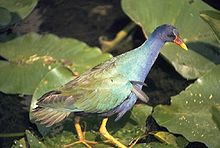

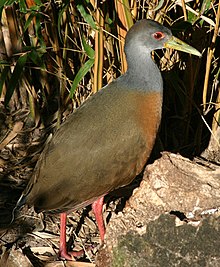
Order: Gruiformes Family: Rallidae
Rallidae is a large family of small to medium-sized birds which includes the rails, crakes, coots, and gallinules. Typically they inhabit dense vegetation in damp environments near lakes, swamps, or rivers. In general they are shy and secretive birds, making them difficult to observe. Most species have strong legs and long toes which are well adapted to soft uneven surfaces. They tend to have short, rounded wings and to be weak fliers.
- Corn crake, Crex crex (V)
- Mangrove rail, Rallus longirostris
- Allen's gallinule, Porphyrio alleni (V)[7]
- American purple gallinule, Porphyrio martinica
- Azure gallinule, Porphyrio flavirostris
- Chestnut-headed crake, Anurolimnas castaneiceps
- Russet-crowned crake, Anurolimnas viridis
- Black-banded crake, Anurolimnas fasciatus
- Rufous-sided crake, Laterallus melanophaius
- Gray-breasted crake, Laterallus exilis
- Black rail, Laterallus jamaicensis
- Red-and-white crake, Laterallus leucopyrrhus
- Rufous-faced crake, Laterallus xenopterus
- Speckled rail, Coturnicops notatus
- Ocellated crake, Micropygia schomburgkii
- Ash-throated crake, Mustelirallus albicollis
- Paint-billed crake, Mustelirallus erythrops
- Spotted rail, Pardirallus maculatus
- Blackish rail, Pardirallus nigricans
- Plumbeous rail, Pardirallus sanguinolentus
- Giant wood-rail, Aramides ypecaha
- Little wood-rail, Aramides mangle (E)
- Gray-cowled wood-rail, Aramides cajaneus
- Red-winged wood-rail, Aramides calopterus
- Slaty-breasted wood-rail, Aramides saracura
- Uniform crake, Amaurolimnas concolor
- Spot-flanked gallinule, Porphyriops melanops
- Yellow-breasted crake, Porzana flaviventer
- Dot-winged crake, Porzana spiloptera (vulnerable)
- Sora, Porzana carolina (V)
- Common gallinule, Gallinula galeata
- Lesser moorhen, Gallinula angulata (V)
- Red-fronted coot, Fulica rufifrons
- Red-gartered coot, Fulica armillata
- White-winged coot, Fulica leucoptera
Finfoots
Order: Gruiformes Family: Heliornithidae
Heliornithidae is a small family of tropical birds with webbed lobes on their feet similar to those of grebes and coots.
- Sungrebe, Heliornis fulica
Plovers
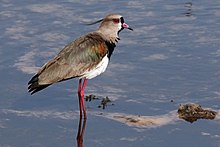
Order: Charadriiformes Family: Charadriidae
The family Charadriidae includes the plovers, dotterels, and lapwings. They are small to medium-sized birds with compact bodies, short thick necks, and long, usually pointed, wings. They are found in open country worldwide, mostly in habitats near water.
- American golden-plover, Pluvialis dominica
- Black-bellied plover, Pluvialis squatarola
- Tawny-throated dotterel, Oreopholus ruficollis
- Pied lapwing, Vanellus cayanus
- Southern lapwing, Vanellus chilensis
- Rufous-chested dotterel, Charadrius modestus
- Semipalmated plover, Charadrius semipalmatus
- Wilson's plover, Charadrius wilsonia
- Collared plover, Charadrius collaris
- Two-banded plover, Charadrius falklandicus
Oystercatchers
Order: Charadriiformes Family: Haematopodidae
The oystercatchers are large and noisy plover-like birds, with strong bills used for smashing or prising open molluscs.
- American oystercatcher, Haematopus palliatus
Avocets and stilts

Order: Charadriiformes Family: Recurvirostridae
Recurvirostridae is a family of large wading birds which includes the avocets and stilts. The avocets have long legs and long up-curved bills. The stilts have extremely long legs and long, thin, straight bills.
- Black-necked stilt, Himantopus mexicanus
Thick-knees
Order: Charadriiformes Family: Burhinidae
The thick-knees are a group of largely tropical waders in the family Burhinidae. They are found worldwide within the tropical zone, with some species also breeding in temperate Europe and Australia. They are medium to large waders with strong black or yellow-black bills, large yellow eyes, and cryptic plumage. Despite being classed as waders, most species have a preference for arid or semi-arid habitats.
- Double-striped thick-knee, Burhinus bistriatus
Sheathbills
Order: Charadriiformes Family: Chionidae
The sheathbills are scavengers of the Antarctic regions. They have white plumage and look plump and dove-like but are believed to be similar to the ancestors of the modern gulls and terns.
- Snowy sheathbill, Chionis alba
Sandpipers


Order: Charadriiformes Family: Scolopacidae
Scolopacidae is a large diverse family of small to medium-sized shorebirds including the sandpipers, curlews, godwits, shanks, tattlers, woodcocks, snipes, dowitchers, and phalaropes. The majority of these species eat small invertebrates picked out of the mud or soil. Variation in length of legs and bills enables multiple species to feed in the same habitat, particularly on the coast, without direct competition for food.
- Upland sandpiper, Bartramia longicauda
- Eskimo curlew, Numenius borealis (believed extinct)
- Whimbrel, Numenius phaeopus
- Bar-tailed godwit, Limosa lapponica (V)
- Hudsonian godwit, Limosa haemastica
- Marbled godwit, Limosa fedoa (V)
- Ruddy turnstone, Arenaria interpres
- Red knot, Calidris canutus
- Ruff, Calidris pugnax (V)
- Stilt sandpiper, Calidris himantopus
- Curlew sandpiper, Calidris ferruginea (V)
- Sanderling, Calidris alba
- Baird's sandpiper, Calidris bairdii
- Little stint, Calidris minuta (V)
- Least sandpiper, Calidris minutilla
- White-rumped sandpiper, Calidris fuscicollis
- Buff-breasted sandpiper, Calidris subruficollis (near-threatened)
- Pectoral sandpiper, Calidris melanotos
- Semipalmated sandpiper, Calidris pusilla
- Western sandpiper, Calidris mauri (V)
- Short-billed dowitcher, Limnodromus griseus
- Giant snipe, Gallinago undulata
- Pantanal snipe, Gallinago paraguaiae
- Wilson's phalarope, Phalaropus tricolor
- Red-necked phalarope, Phalaropus lobatus (V)
- Red phalarope, Phalaropus fulicarius (V)
- Terek sandpiper, Xenus cinereus (V)
- Spotted sandpiper, Actitis macularia
- Solitary sandpiper, Tringa solitaria
- Greater yellowlegs, Tringa melanoleuca
- Willet, Tringa semipalmata
- Lesser yellowlegs, Tringa flavipes
- Common redshank, Tringa totanus (V)
- Wood sandpiper, Tringa glareola (V)
Seedsnipes
Order: Charadriiformes Family: Thinocoridae
The seedsnipes are a small family of birds that superficially resemble sparrows. They have short legs and long wings and are herbivorous waders.
- Least seedsnipe, Thinocorus rumicivorus (V)
Jacanas
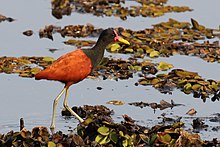
Order: Charadriiformes Family: Jacanidae
The jacanas are a family of waders found throughout the tropics. They are identifiable by their huge feet and claws which enable them to walk on floating vegetation in the shallow lakes that are their preferred habitat.
- Wattled jacana, Jacana jacana
Painted-snipes
Order: Charadriiformes Family: Rostratulidae
Painted-snipes are short-legged, long-billed birds similar in shape to the true snipes, but more brightly colored.
- South American painted-snipe, Nycticryphes semicollaris
Pratincoles and coursers
Order: Charadriiformes Family: Glareolidae
Glareolidae is a family of wading birds comprising the pratincoles, which have short legs, long pointed wings and long forked tails, and the coursers, which have long legs, short wings and long, pointed bills which curve downwards.
- Collared pratincole, Glareola pratincola (V)
Skuas

Order: Charadriiformes Family: Stercorariidae
The family Stercorariidae are, in general, medium to large birds, typically with gray or brown plumage, often with white markings on the wings. They nest on the ground in temperate and arctic regions and are long-distance migrants.
- Great skua, Stercorarius skua
- Chilean skua, Stercorarius chilensis
- South polar skua, Stercorarius maccormicki
- Brown skua, Stercorarius antarcticus
- Pomarine jaeger, Stercorarius pomarinus
- Parasitic jaeger, Stercorarius parasiticus
- Long-tailed jaeger, Stercorarius longicaudus
Skimmers
Order: Charadriiformes Family: Rynchopidae
Skimmers are a small family of tropical tern-like birds. They have an elongated lower mandible which they use to feed by flying low over the water surface and skimming the water for small fish.
- Black skimmer, Rynchops niger
Gulls


Order: Charadriiformes Family: Laridae
Laridae is a family of medium to large seabirds and includes gulls, terns and skimmers. Gulls are typically gray or white, often with black markings on the head or wings. They have longish bills and webbed feet. Terns are a group of generally medium to large seabirds typically with grey or white plumage, often with black markings on the head. Most terns hunt fish by diving but some pick insects off the surface of fresh water. Terns are generally long-lived birds, with several species known to live in excess of 30 years.
- Sabine's gull, Xema sabini (V)
- Brown-hooded gull, Chroicocephalus maculipennis
- Gray-hooded gull, Chroicocephalus cirrocephalus
- Black-headed gull, Chroicocephalus ridibundus (V)
- Gray gull, Leucophaeus modestus (V)
- Laughing gull, Leucophaeus atricilla
- Franklin's gull, Leucophaeus pipixcan (V)
- Olrog's gull, Larus atlanticus
- Ring-billed gull, Larus delawarensis (V)
- Kelp gull, Larus dominicanus
- Lesser black-backed gull, Larus fuscus (V)
- Brown noddy, Anous stolidus
- Black noddy, Anous minutus
- White tern, Gygis alba
- Sooty tern, Onychoprion fuscata
- Least tern, Sternula antillarum
- Yellow-billed tern, Sternula superciliaris
- Large-billed tern, Phaetusa simplex
- Gull-billed tern, Gelochelidon nilotica
- Black tern, Chlidonias niger
- White-winged tern, Chlidonias leucopterus (V)
- Common tern, Sterna hirundo
- Roseate tern, Sterna dougallii
- Arctic tern, Sterna paradisaea
- South American tern, Sterna hirundinacea
- Antarctic tern, Sterna vittata (V)
- Snowy-crowned tern, Sterna trudeaui
- Sandwich tern, Thalasseus sandvicensis
- Royal tern, Thalasseus maximus
Sunbittern

Order: Eurypygiformes Family: Eurypygidae
The sunbittern is a bittern-like bird of tropical regions of the Americas and the sole member of the family Eurypygidae (sometimes spelled Eurypigidae) and genus Eurypyga.
- Sunbittern, Eurypyga helias
Tropicbirds

Order: Phaethontiformes Family: Phaethontidae
Tropicbirds are slender white birds of tropical oceans, with exceptionally long central tail feathers. Their heads and long wings have black markings.
- Red-billed tropicbird, Phaethon aethereus
- Red-tailed tropicbird, Phaethon rubricauda (V)
- White-tailed tropicbird, Phaethon lepturus
Penguins

Order: Sphenisciformes Family: Spheniscidae
The penguins are a group of aquatic, flightless birds living almost exclusively in the Southern Hemisphere. Most penguins feed on krill, fish, squid, and other forms of sealife caught while swimming underwater.
- King penguin, Aptenodytes patagonicus (V)
- Magellanic penguin, Spheniscus magellanicus
- Macaroni penguin, Eudyptes chrysolophus (V) (vulnerable)
- Rockhopper penguin, Eudyptes chrysocome (V) (vulnerable)
Albatrosses
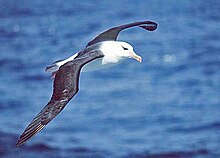
Order: Procellariiformes Family: Diomedeidae
The albatrosses are among the largest of flying birds, and the great albatrosses from the genus Diomedea have the largest wingspans of any extant birds.
- Royal albatross, Diomedea epomophora
- Wandering albatross, Diomedea exulans
- Sooty albatross, Phoebetria fusca (endangered)
- Light-mantled albatross, Phoebetria palpebrata
- Yellow-nosed albatross, Thalassarche chlororhynchos
- Black-browed albatross, Thalassarche melanophris
- Gray-headed albatross, Thalassarche chrysostoma (V) (endangered)
- White-capped albatross, Thalassarche cauta (V) (near-threatened)
Southern storm-petrels
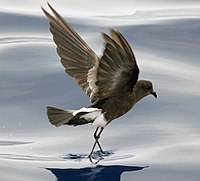
Order: Procellariiformes Family: Oceanitidae
The storm-petrels are the smallest seabirds, relatives of the petrels, feeding on planktonic crustaceans and small fish picked from the surface, typically while hovering. The flight is fluttering and sometimes bat-like. Until 2018, this family's species were included with the other storm-petrels in family Hydrobatidae.
- White-bellied storm-petrel, Fregetta grallaria
- Black-bellied storm-petrel, Fregetta tropica
- Wilson's storm-petrel, Oceanites oceanicus
- White-faced storm-petrel, Pelagodroma marina (V)
Northern storm-petrels
Order: Procellariiformes Family: Hydrobatidae
Though the members of this family are similar in many respects to the southern storm-petrels, including their general appearance and habits, there are enough genetic differences to warrant their placement in a separate family.
- Band-rumped storm-petrel, Hydrobates castro (H)
- Leach's storm-petrel, Hydrobates leucorhoa
Shearwaters

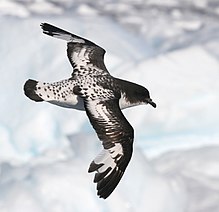
Order: Procellariiformes Family: Procellariidae
The procellariids are the main group of medium-sized "true petrels", characterized by united nostrils with medium septum and a long outer functional primary.
- Southern giant-petrel, Macronectes giganteus
- Northern giant-petrel, Macronectes halli
- Southern fulmar, Fulmarus glacialoides
- Cape petrel, Daption capense
- Kerguelen petrel, Aphrodroma brevirostris (V)
- Great-winged petrel, Pterodroma macroptera (V)
- Soft-plumaged petrel, Pterodroma mollis
- Black-capped petrel, Pterodroma hasitata (H) (endangered)
- Atlantic petrel, Pterodroma incerta (endangered)
- White-headed petrel, Pterodroma lessonii (V)
- Trindade petrel, Pterodroma arminjoniana
- Fea's petrel, Pterodroma feae
- Blue petrel, Halobaena caerulea
- Broad-billed prion, Pachyptila vittata (V)
- Antarctic prion, Pachyptila desolata
- Slender-billed prion, Pachyptila belcheri
- Bulwer's petrel, Bulweria bulwerii
- Gray petrel, Procellaria cinerea (V) (near-threatened)
- White-chinned petrel, Procellaria aequinoctialis
- Spectacled petrel, Procellaria conspicillata
- Cory's shearwater, Calonectris diomedea
- Cape Verde shearwater, Calonectris edwardsii
- Short-tailed shearwater, Ardenna tenuirostris (V)
- Sooty shearwater, Ardenna grisea
- Great shearwater, Ardenna gravis
- Manx shearwater, Puffinus puffinus
- Little shearwater, Puffinus assimilis (H)
- Audubon's shearwater, Puffinus lherminieri
- Magellanic diving-petrel, Pelecanoides magellani (V)
Storks

Order: Ciconiiformes Family: Ciconiidae
Storks are large, long-legged, long-necked wading birds with long, stout bills. Storks are mute, but bill-clattering is an important mode of communication at the nest. Their nests can be large and may be reused for many years. Many species are migratory.
- Maguari stork, Ciconia maguari
- Jabiru, Jabiru mycteria
- Wood stork, Mycteria americana
Frigatebirds

Order: Suliformes Family: Fregatidae
Frigatebirds are large seabirds usually found over tropical oceans. They are large, black-and-white or completely black, with long wings and deeply forked tails. The males have colored inflatable throat pouches. They do not swim or walk and cannot take off from a flat surface. Having the largest wingspan-to-body-weight ratio of any bird, they are essentially aerial, able to stay aloft for more than a week.
- Lesser frigatebird, Fregata ariel
- Ascension frigatebird, Fregata aquila (V)
- Magnificent frigatebird, Fregata magnificens
- Great frigatebird, Fregata minor
Boobies
Order: Suliformes Family: Sulidae
The sulids comprise the gannets and boobies. Both groups are medium to large coastal seabirds that plunge-dive for fish.
- Cape gannet, Morus capensis (V) (endangered)
- Australasian gannet, Morus serrator (V)
- Masked booby, Sula dactylatra
- Red-footed booby, Sula sula
- Brown booby, Sula leucogaster
Anhingas

Order: Suliformes Family: Anhingidae
Anhingas are often called "snake-birds" because of their long thin neck, which gives a snake-like appearance when they swim with their bodies submerged. The males have black and dark-brown plumage, an erectile crest on the nape, and a larger bill than the female. The females have much paler plumage especially on the neck and underparts. The darters have completely webbed feet and their legs are short and set far back on the body. Their plumage is somewhat permeable, like that of cormorants, and they spread their wings to dry after diving.
- Anhinga, Anhinga anhinga
Cormorants
Order: Suliformes Family: Phalacrocoracidae
Phalacrocoracidae is a family of medium to large coastal, fish-eating seabirds that includes cormorants and shags. Plumage coloration varies, with the majority having mainly dark plumage, some species being black-and-white, and a few being colorful.
- Neotropic cormorant, Phalacrocorax brasilianus
- Imperial cormorant, Phalacrocorax atriceps (H)
Pelicans
Order: Pelecaniformes Family: Pelecanidae
Pelicans are large water birds with a distinctive pouch under their beak. As with other members of the order Pelecaniformes, they have webbed feet with four toes.
- Brown pelican, Pelecanus occidentalis (V)
Herons


Order: Pelecaniformes Family: Ardeidae
The family Ardeidae contains the bitterns, herons, and egrets. Herons and egrets are medium to large wading birds with long necks and legs. Bitterns tend to be shorter necked and more wary. Members of Ardeidae fly with their necks retracted, unlike other long-necked birds such as storks, ibises, and spoonbills.
- Rufescent tiger-heron, Tigrisoma lineatum
- Fasciated tiger-heron, Tigrisoma fasciatum
- Agami heron, Agamia agami
- Boat-billed heron, Cochlearius cochlearius
- Zigzag heron, Zebrilus undulatus
- Pinnated bittern, Botaurus pinnatus
- Least bittern, Ixobrychus exilis
- Stripe-backed bittern, Ixobrychus involucris
- Black-crowned night-heron, Nycticorax nycticorax
- Yellow-crowned night-heron, Nyctanassa violacea
- Striated heron, Butorides striata
- Squacco heron, Ardeola ralloides (V)
- Cattle egret, Bubulcus ibis
- Gray heron, Ardea cinerea (V)
- Great blue heron, Ardea herodias (H)
- Cocoi heron, Ardea cocoi
- Purple heron, Ardea purpurea (V)
- Great egret, Ardea alba
- Whistling heron, Syrigma sibilatrix
- Capped heron, Pilherodius pileatus
- Tricolored heron, Egretta tricolor
- Western reef-heron, Egretta gularis (V)
- Little egret, Egretta garzetta (V)
- Snowy egret, Egretta thula
- Little blue heron, Egretta caerulea
Ibises
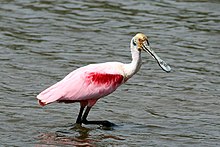
Order: Pelecaniformes Family: Threskiornithidae
Threskiornithidae is a family of large terrestrial and wading birds which includes the ibises and spoonbills. They have long, broad wings with 11 primary and about 20 secondary feathers. They are strong fliers and despite their size and weight, very capable soarers.
- Scarlet ibis, Eudocimus ruber
- White-faced ibis, Plegadis chihi
- Sharp-tailed ibis, Cercibis oxycerca
- Green ibis, Mesembrinibis cayennensis
- Bare-faced ibis, Phimosus infuscatus
- Plumbeous ibis, Theristicus caerulescens
- Buff-necked ibis, Theristicus caudatus
- Eurasian spoonbill, Platalea leucorodia (V)
- Roseate spoonbill, Platalea ajaja
New World vultures
Order: Cathartiformes Family: Cathartidae
The New World vultures are not closely related to Old World vultures, but superficially resemble them because of convergent evolution. Like the Old World vultures, they are scavengers. However, unlike Old World vultures, which find carcasses by sight, New World vultures have a good sense of smell with which they locate carrion.
- King vulture, Sarcoramphus papa
- Andean condor, Vultur gryphus (H)
- Black vulture, Coragyps atratus
- Turkey vulture, Cathartes aura
- Lesser yellow-headed vulture, Cathartes burrovianus
- Greater yellow-headed vulture, Cathartes melambrotus
Osprey
Order: Accipitriformes Family: Pandionidae
The family Pandionidae contains only one species, the osprey. The osprey is a medium-large raptor which is a specialist fish-eater with a worldwide distribution.
- Osprey, Pandion haliaetus
Hawks
Order: Accipitriformes Family: Accipitridae
Accipitridae is a family of birds of prey, which includes hawks, eagles, kites, harriers, and Old World vultures. These birds have powerful hooked beaks for tearing flesh from their prey, strong legs, powerful talons, and keen eyesight.
- Pearl kite, Gampsonyx swainsonii
- White-tailed kite, Elanus leucurus
- Hook-billed kite, Chondrohierax uncinatus
- Gray-headed kite, Leptodon cayanensis
- White-collared kite, Leptodon forbesi (E) (endangered)
- Swallow-tailed kite, Elanoides forficatus
- Crested eagle, Morphnus guianensis (near-threatened)
- Harpy eagle, Harpia harpyja (near-threatened)
- Black hawk-eagle, Spizaetus tyrannus
- Black-and-white hawk-eagle, Spizaetus melanoleucus
- Ornate hawk-eagle, Spizaetus ornatus
- Black-collared hawk, Busarellus nigricollis
- Snail kite, Rostrhamus sociabilis
- Slender-billed kite, Helicolestes hamatus
- Double-toothed kite, Harpagus bidentatus
- Rufous-thighed kite, Harpagus diodon
- Mississippi kite, Ictinia mississippiensis
- Plumbeous kite, Ictinia plumbea
- Cinereous harrier, Circus cinereus
- Long-winged harrier, Circus buffoni
- Gray-bellied hawk, Accipiter poliogaster
- Sharp-shinned hawk, Accipiter striatus
- Bicolored hawk, Accipiter bicolor
- Tiny hawk, Microspizias superciliosus
- Black kite, Milvus migrans (V)
- Crane hawk, Geranospiza caerulescens
- Slate-colored hawk, Buteogallus schistaceus
- Common black hawk, Buteogallus anthracinus (H)
- Rufous crab hawk, Buteogallus aequinoctialis
- Savanna hawk, Buteogallus meridionalis
- White-necked hawk, Buteogallus lacernulatus (E) (vulnerable)
- Great black hawk, Buteogallus urubitinga
- Solitary eagle, Buteogallus solitarius
- Chaco eagle, Buteogallus coronatus (endangered)
- Roadside hawk, Rupornis magnirostris
- Harris's hawk, Parabuteo unicinctus
- White-rumped hawk, Parabuteo leucorrhous
- White-tailed hawk, Geranoaetus albicaudatus
- Variable hawk, Geranoaetus polyosoma (H)
- Black-chested buzzard-eagle, Geranoaetus melanoleucus
- Mantled hawk, Pseudastur polionotus (near-threatened)
- White hawk, Pseudastur albicollis
- Black-faced hawk, Leucopternis melanops
- White-browed hawk, Leucopternis kuhli
- Gray-lined hawk, Buteo nitidus
- Broad-winged hawk, Buteo platypterus
- Short-tailed hawk, Buteo brachyurus
- Swainson's hawk, Buteo swainsoni
- Zone-tailed hawk, Buteo albonotatus
- Great black hawk
- White-tailed hawk
- Roadside hawk
- Black-collared hawk
Barn owls
Order: Strigiformes Family: Tytonidae
Barn owls are medium to large owls with large heads and characteristic heart-shaped faces. They have long strong legs with powerful talons.
- Barn owl, Tyto alba
Owls


Order: Strigiformes Family: Strigidae
The typical owls are small to large solitary nocturnal birds of prey. They have large forward-facing eyes and ears, a hawk-like beak, and a conspicuous circle of feathers around each eye called a facial disk.
- Tropical screech-owl, Megascops choliba
- Foothill screech-owl, Megascops roraimae
- Long-tufted screech-owl, Megascops sanctaecatarinae
- Tawny-bellied screech-owl, Megascops watsonii
- Black-capped screech-owl, Megascops atricapilla
- Crested owl, Lophostrix cristata
- Spectacled owl, Pulsatrix perspicillata
- Tawny-browed owl, Pulsatrix koeniswaldiana
- Great horned owl, Bubo virginianus
- Rusty-barred owl, Strix hylophila
- Mottled owl, Strix virgata
- Black-banded owl, Strix huhula
- Amazonian pygmy-owl, Glaucidium hardyi
- Pernambuco pygmy-owl, Glaucidium mooreorum (E) (critically endangered)
- Least pygmy-owl, Glaucidium minutissimum (E)
- Ferruginous pygmy-owl, Glaucidium brasilianum
- Burrowing owl, Athene cunicularia
- Buff-fronted owl, Aegolius harrisii
- Striped owl, Asio clamator
- Stygian owl, Asio stygius
- Short-eared owl, Asio flammeus
Trogons

Order: Trogoniformes Family: Trogonidae
The family Trogonidae includes trogons and quetzals. Found in tropical woodlands worldwide, they feed on insects and fruit, and their broad bills and weak legs reflect their diet and arboreal habits. Although their flight is fast, they are reluctant to fly any distance. Trogons have soft, often colorful, feathers with distinctive male and female plumage.
- Pavonine quetzal, Pharomachrus pavoninus
- Black-tailed trogon, Trogon melanurus
- Green-backed trogon, Trogon viridis
- Amazonian trogon, Trogon ramonianus
- Guianan trogon, Trogon violaceus
- Blue-crowned trogon, Trogon curucui
- Surucua trogon, Trogon surrucura
- Black-throated trogon, Trogon rufus (see note)[note 2]
- Collared trogon, Trogon collaris
- Masked trogon, Trogon personatus
Motmots
Order: Coraciiformes Family: Momotidae
The motmots have colorful plumage and long, graduated tails which they display by waggling back and forth. In most of the species, the barbs near the ends of the two longest (central) tail feathers are weak and fall off, leaving a length of bare shaft and creating a racket-shaped tail.
- Broad-billed motmot, Electron platyrhynchum
- Rufous motmot, Baryphthengus martii
- Rufous-capped motmot, Baryphthengus ruficapillus
- Amazonian motmot, Momotus momota
Kingfishers

Order: Coraciiformes Family: Alcedinidae
Kingfishers are medium-sized birds with large heads, long pointed bills, short legs, and stubby tails.
- Ringed kingfisher, Megaceryle torquata
- Amazon kingfisher, Chloroceryle amazona
- American pygmy kingfisher, Chloroceryle aenea
- Green kingfisher, Chloroceryle americana
- Green-and-rufous kingfisher, Chloroceryle inda
Jacamars

Order: Galbuliformes Family: Galbulidae
The jacamars are near passerine birds from tropical South America with a range that extends up to Mexico. They feed on insects caught on the wing and are glossy, elegant birds with long bills and tails. They resemble the Old World bee-eaters, although they are more closely related to puffbirds.
- White-eared jacamar, Galbalcyrhynchus leucotis
- Purus jacamar, Galbalcyrhynchus purusianus
- White-throated jacamar, Brachygalba albogularis
- Brown jacamar, Brachygalba lugubris
- Three-toed jacamar, Jacamaralcyon tridactyla (E) (vulnerable)
- Yellow-billed jacamar, Galbula albirostris
- Blue-cheeked jacamar, Galbula cyanicollis
- Rufous-tailed jacamar, Galbula ruficauda
- Green-tailed jacamar, Galbula galbula
- White-chinned jacamar, Galbula tombacea
- Bluish-fronted jacamar, Galbula cyanescens
- Purplish jacamar, Galbula chalcothorax
- Bronzy jacamar, Galbula leucogastra
- Paradise jacamar, Galbula dea
- Great jacamar, Jacamerops aureus
Puffbirds

Order: Galbuliformes Family: Bucconidae
The puffbirds are related to the jacamars and have the same range, but lack the iridescent colors of that family. They are mainly brown, rufous, or gray, with large heads and flattened bills with hooked tips. The loose abundant plumage and short tails makes them look stout and puffy, giving rise to the English common name of the family.
- White-necked puffbird, Notharchus hyperrhynchus
- Guianan puffbird, Notharchus macrorhynchos
- Buff-bellied puffbird, Notharchus swainsoni
- Brown-banded puffbird, Notharchus ordii
- Pied puffbird, Notharchus tectus
- Chestnut-capped puffbird, Bucco macrodactylus
- Spotted puffbird, Bucco tamatia
- Collared puffbird, Bucco capensis
- Western striolated-puffbird, Nystalus obamai
- Eastern striolated-puffbird, Nystalus striolatus
- White-eared puffbird, Nystalus chacuru
- Spot-backed puffbird, Nystalus maculatus
- White-chested puffbird, Malacoptila fusca
- Semicollared puffbird, Malacoptila semicincta
- Crescent-chested puffbird, Malacoptila striata (E)
- Rufous-necked puffbird, Malacoptila rufa
- Lanceolated monklet, Micromonacha lanceolata
- Rusty-breasted nunlet, Nonnula rubecula
- Fulvous-chinned nunlet, Nonnula sclateri
- Rufous-capped nunlet, Nonnula ruficapilla
- Chestnut-headed nunlet, Nonnula amaurocephala (E)
- Black nunbird, Monasa atra
- Black-fronted nunbird, Monasa nigrifrons
- White-fronted nunbird, Monasa morphoeus
- Yellow-billed nunbird, Monasa flavirostris
- Swallow-winged puffbird, Chelidoptera tenebrosa
New World barbets
Order: Piciformes Family: Capitonidae
The barbets are plump birds, with short necks and large heads. They get their name from the bristles which fringe their heavy bills. Most species are brightly colored.
- Scarlet-crowned barbet, Capito aurovirens
- Black-girdled barbet, Capito dayi
- Brown-chested barbet, Capito brunneipectus (E)
- Black-spotted barbet, Capito niger
- Gilded barbet, Capito auratus
- Lemon-throated barbet, Eubucco richardsoni
- Scarlet-hooded barbet, Eubucco tucinkae
Toucans


Order: Piciformes Family: Ramphastidae
Toucans are near passerine birds from the Neotropics. They are brightly marked and have enormous, colorful bills which in some species amount to half their body length.
- Southern emerald-toucanet, Aulacorhynchus albivitta
- Tepui toucanet, Aulacorhynchus whitelianus
- Saffron toucanet, Pteroglossus bailloni (near-threatened)
- Green aracari, Pteroglossus viridis
- Lettered aracari, Pteroglossus inscriptus
- Black-necked aracari, Pteroglossus aracari
- Chestnut-eared aracari, Pteroglossus castanotis
- Many-banded aracari, Pteroglossus pluricinctus
- Ivory-billed aracari, Pteroglossus azara
- Curl-crested aracari, Pteroglossus beauharnaisii
- Red-necked aracari, Pteroglossus bitorquatus
- Guianan toucanet, Selenidera piperivora
- Golden-collared toucanet, Selenidera reinwardtii
- Tawny-tufted toucanet, Selenidera nattereri
- Gould's toucanet, Selenidera gouldii
- Spot-billed toucanet, Selenidera maculirostris
- Toco toucan, Ramphastos toco
- White-throated toucan, Ramphastos tucanus
- Channel-billed toucan, Ramphastos vitellinus
- Red-breasted toucan, Ramphastos dicolorus
Woodpeckers

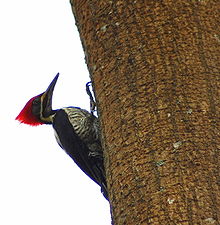

Order: Piciformes Family: Picidae
Woodpeckers are small to medium-sized birds with chisel-like beaks, short legs, stiff tails, and long tongues used for capturing insects. Some species have feet with two toes pointing forward and two backward, while several species have only three toes. Many woodpeckers have the habit of tapping noisily on tree trunks with their beaks.
- Bar-breasted piculet, Picumnus aurifrons
- Orinoco piculet, Picumnus pumilus
- Lafresnaye's piculet, Picumnus lafresnayi
- Golden-spangled piculet, Picumnus exilis
- White-bellied piculet, Picumnus spilogaster
- Ochraceous piculet, Picumnus limae (E)
- Spotted piculet, Picumnus pygmaeus (E)
- Varzea piculet, Picumnus varzeae (E)
- White-barred piculet, Picumnus cirratus
- Ochre-collared piculet, Picumnus temminckii
- White-wedged piculet, Picumnus albosquamatus
- Rusty-necked piculet, Picumnus fuscus
- Rufous-breasted piculet, Picumnus rufiventristhreatened)
- Mottled piculet, Picumnus nebulosus (near-threatened)
- Plain-breasted piculet, Picumnus castelnau
- Fine-barred piculet, Picumnus subtilis
- White woodpecker, Melanerpes candidus
- Yellow-tufted woodpecker, Melanerpes cruentatus
- Yellow-fronted woodpecker, Melanerpes flavifrons
- White-fronted woodpecker, Melanerpes cactorum
- Red-rumped woodpecker, Dryobates kirkii
- Golden-collared woodpecker, Dryobates cassini
- White-spotted woodpecker, Dryobates spilogaster
- Checkered woodpecker, Dryobates mixtus
- Little woodpecker, Dryobates passerinus
- Red-stained woodpecker, Dryobates affinis
- Yellow-eared woodpecker, Dryobates maculifrons (E)
- Red-necked woodpecker, Campephilus rubricollis
- Robust woodpecker, Campephilus robustus
- Crimson-crested woodpecker, Campephilus melanoleucos
- Cream-backed woodpecker, Campephilus leucopogon
- Lineated woodpecker, Dryocopus lineatus
- Ringed woodpecker, Celeus torquatus
- Helmeted woodpecker, Celeus galeatus (vulnerable)
- Scale-breasted woodpecker, Celeus grammicus
- Waved woodpecker, Celeus undatus
- Cream-colored woodpecker, Celeus flavus
- Rufous-headed woodpecker, Celeus spectabilis
- Kaempfer's woodpecker, Celeus obrieni (E)
- Ochre-backed woodpecker, Celeus ochraceus (E)
- Chestnut woodpecker, Celeus elegans
- Pale-crested woodpecker, Celeus lugubris
- Blond-crested woodpecker, Celeus flavescens
- White-throated woodpecker, Piculus leucolaemus
- Yellow-throated woodpecker, Piculus flavigula
- Golden-green woodpecker, Piculus chrysochloros
- White-browed woodpecker, Piculus aurulentus (near-threatened)
- Golden-olive woodpecker, Colaptes rubiginosus
- Spot-breasted woodpecker, Colaptes punctigula
- Green-barred woodpecker, Colaptes melanochloros
- Campo flicker, Colaptes campestris
Seriemas

Order: Cariamiformes Family: Cariamidae
The seriemas are terrestrial birds which run rather than fly (though they are able to fly for short distances). They have long legs, necks and tails, but only short wings, reflecting their way of life. They are brownish birds with short bills and erectile crests, found on fairly-dry open grasslands.
- Red-legged seriema, Cariama cristata
Falcons


Order: Falconiformes Family: Falconidae
Falconidae is a family of diurnal birds of prey. They differ from hawks, eagles and kites in that they kill with their beaks instead of their talons.
- Laughing falcon, Herpetotheres cachinnans
- Barred forest-falcon, Micrastur ruficollis
- Lined forest-falcon, Micrastur gilvicollis
- Cryptic forest-falcon, Micrastur mintoni
- Slaty-backed forest-falcon, Micrastur mirandollei
- Collared forest-falcon, Micrastur semitorquatus
- Buckley's forest-falcon, Micrastur buckleyi
- Crested caracara, Caracara plancus
- Red-throated caracara, Ibycter americanus
- Black caracara, Daptrius ater
- Yellow-headed caracara, Milvago chimachima
- Chimango caracara, Milvago chimango
- Eurasian kestrel, Falco tinnunculus (V)
- American kestrel, Falco sparverius
- Merlin, Falco columbarius (V)
- Bat falcon, Falco rufigularis
- Orange-breasted falcon, Falco deiroleucus
- Aplomado falcon, Falco femoralis
- Peregrine falcon, Falco peregrinus
New World and African parrots
Order: Psittaciformes Family: Psittacidae
Parrots are small to large birds with a characteristic curved beak. Their upper mandibles have slight mobility in the joint with the skull and they have a generally erect stance. All parrots are zygodactyl, having the four toes on each foot placed two at the front and two to the back.
- Scarlet-shouldered parrotlet, Touit huetii
- Sapphire-rumped parrotlet, Touit purpuratus
- Brown-backed parrotlet, Touit melanonotus (E) (vulnerable)
- Golden-tailed parrotlet, Touit surdus (E) (vulnerable)
- Tepui parrotlet, Nannopsittaca panychlora
- Amazonian parrotlet, Nannopsittaca dachilleae
- Monk parakeet, Myiopsitta monachus
- Tui parakeet, Brotogeris sanctithomae
- Plain parakeet, Brotogeris tirica (E)
- Canary-winged parakeet, Brotogeris versicolurus
- Yellow-chevroned parakeet, Brotogeris chiriri
- Cobalt-winged parakeet, Brotogeris cyanoptera
- Golden-winged parakeet, Brotogeris chrysoptera
- Pileated parrot, Pionopsitta pileata
- Blue-bellied parrot, Triclaria malachitacea (E) (near-threatened)
- Orange-cheeked parrot, Pyrilia barrabandi
- Caica parrot, Pyrilia caica
- Bald parrot, Pyrilia aurantiocephala (E)
- Vulturine parrot, Pyrilia vulturina (E)
- Dusky parrot, Pionus fuscus
- Scaly-headed parrot, Pionus maximiliani
- Blue-headed parrot, Pionus menstruus
- Short-tailed parrot, Graydidascalus brachyurus
- Yellow-faced parrot, Alipiopsitta xanthops (near-threatened)
- Festive parrot, Amazona festiva
- Vinaceous-breasted parrot, Amazona vinacea (endangered)
- Red-spectacled parrot, Amazona pretrei (E) (vulnerable)
- Red-lored parrot, Amazona autumnalis
- Blue-cheeked parrot, Amazona dufresniana (near-threatened)
- Red-browed parrot, Amazona rhodocorytha (E) (vulnerable)
- Yellow-crowned parrot, Amazona ochrocephala
- Turquoise-fronted parrot, Amazona aestiva
- Mealy parrot, Amazona farinosa
- Kawall's parrot, Amazona kawalli (E)
- Red-tailed parrot, Amazona brasiliensis (E) (near-threatened)
- Orange-winged parrot, Amazona amazonica
- Dusky-billed parrotlet, Forpus modestus
- Riparian parrotlet, Forpus crassirostris
- Cobalt-rumped parrotlet, Forpus xanthopterygius
- Green-rumped parrotlet, Forpus passerinus
- Black-headed parrot, Pionites melanocephalus
- White-bellied parrot, Pionites leucogaster
- Red-fan parrot, Deroptyus accipitrinus
- Ochre-marked parakeet, Pyrrhura cruentata (E) (vulnerable)
- Blaze-winged parakeet, Pyrrhura devillei
- Maroon-bellied parakeet, Pyrrhura frontalis
- Pearly parakeet, Pyrrhura lepida (E) (vulnerable)
- Crimson-bellied parakeet, Pyrrhura perlata
- Green-cheeked parakeet, Pyrrhura molinae
- Pfrimer's parakeet, Pyrrhura pfrimeri (E)
- Gray-breasted parakeet, Pyrrhura griseipectus (E)
- Maroon-faced parakeet, Pyrrhura leucotis (E)
- Painted parakeet, Pyrrhura picta
- Santarem parakeet, Pyrrhura amazonum
- Bonaparte's parakeet, Pyrrhura lucianii
- Rose-fronted parakeet, Pyrrhura roseifrons
- Fiery-shouldered parakeet, Pyrrhura egregia
- Maroon-tailed parakeet, Pyrrhura melanura
- Black-capped parakeet, Pyrrhura rupicola
- Hyacinth macaw, Anodorhynchus hyacinthinus (vulnerable)
- Glaucous macaw, Anodorhynchus glaucus (critically endangered, possibly extinct)[8]
- Indigo macaw, Anodorhynchus leari (E) (endangered)
- Peach-fronted parakeet, Eupsittula aurea
- Brown-throated parakeet, Eupsittula pertinax
- Cactus parakeet, Eupsittula cactorum (E)
- Dusky-headed parakeet, Aratinga weddellii
- Nanday parakeet, Aratinga nenday
- Sun parakeet, Aratinga solstitialis
- Sulphur-breasted parakeet, Aratinga maculata
- Jandaya parakeet, Aratinga jandaya (E)
- Golden-capped parakeet, Aratinga auricapillus (E)
- Spix's macaw, Cyanopsitta spixii (E) (extinct in the wild)
- Red-bellied macaw, Orthopsittaca manilatus
- Blue-winged macaw, Primolius maracana (near-threatened)
- Blue-headed macaw, Primolius couloni
- Yellow-collared macaw, Primolius auricollis
- Blue-and-yellow macaw, Ara ararauna
- Chestnut-fronted macaw, Ara severus
- Scarlet macaw, Ara macao
- Red-and-green macaw, Ara chloropterus
- Golden parakeet, Guaruba guarouba (E) (vulnerable)
- Blue-crowned parakeet, Thectocercus acuticaudatus
- Red-shouldered macaw, Diopsittaca nobilis
- White-eyed parakeet, Psittacara leucophthalmus
- Hyacinth macaw
- Red-and-green macaws
- Jandaya parakeet
- Turquoise-fronted parrot
- Maroon-bellied parakeet
- Monk parakeet
- Yellow-faced parrot
Antbirds
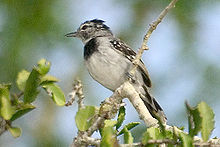
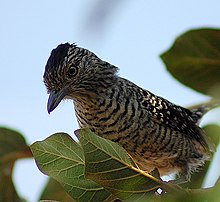
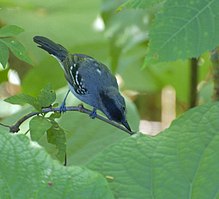
Order: Passeriformes Family: Thamnophilidae
The antbirds are a large family of small passerine birds of subtropical and tropical Central and South America. They are forest birds which tend to feed on insects at or near the ground. A sizable minority of them specialize in following columns of army ants to eat small invertebrates that leave their hiding places to flee from the ants. Many species lack bright color, with brown, black, and white being the dominant tones.
- Chestnut-shouldered antwren, Euchrepomis humeralis
- Ash-winged antwren, Euchrepomis spodioptila
- Fasciated antshrike, Cymbilaimus lineatus
- Bamboo antshrike, Cymbilaimus sanctaemariae
- Spot-backed antshrike, Hypoedaleus guttatus
- Giant antshrike, Batara cinerea
- Large-tailed antshrike, Mackenziaena leachii
- Tufted antshrike, Mackenziaena severa
- Black-throated antshrike, Frederickena viridis
- Undulated antshrike, Frederickena unduliger
- Great antshrike, Taraba major
- Black-crested antshrike, Sakesphorus canadensis
- Glossy antshrike, Sakesphorus luctuosus (E)
- Caatinga antwren, Radinopsyche sellowi (E)
- White-bearded antshrike, Biatas nigropectus (vulnerable)
- Barred antshrike, Thamnophilus doliatus
- Rufous-capped antshrike, Thamnophilus ruficapillus
- Rufous-winged antshrike, Thamnophilus torquatus
- Chestnut-backed antshrike, Thamnophilus palliatus
- Plain-winged antshrike, Thamnophilus schistaceus
- Mouse-colored antshrike, Thamnophilus murinus
- Castelnau's antshrike, Thamnophilus cryptoleucus
- Blackish-gray antshrike, Thamnophilus nigrocinereus
- Northern slaty-antshrike, Thamnophilus punctatus
- Natterer's slaty-antshrike, Thamnophilus stictocephalus
- Bolivian slaty-antshrike, Thamnophilus sticturus
- Planalto slaty-antshrike, Thamnophilus pelzelni (E)
- Sooretama slaty-antshrike, Thamnophilus ambiguus (E)
- Variable antshrike, Thamnophilus caerulescens
- White-shouldered antshrike, Thamnophilus aethiops
- Band-tailed antshrike, Thamnophilus melanothorax
- Amazonian antshrike, Thamnophilus amazonicus
- Streak-backed antshrike, Thamnophilus insignis
- Acre antshrike, Thamnophilus divisorius
- Star-throated antwren, Rhopias gularis (E)
- Pearly antshrike, Megastictus margaritatus
- Black bushbird, Neoctantes niger
- Rondonia bushbird, Clytoctantes atrogularis (E) (vulnerable)
- Silvery-cheeked antshrike, Sakesphoroides cristatus (E)
- Spot-breasted antvireo, Dysithamnus stictothorax (E) (near-threatened)
- Plain antvireo, Dysithamnus mentalis
- Rufous-backed antvireo, Dysithamnus xanthopterus (E)
- Plumbeous antvireo, Dysithamnus plumbeus (E) (vulnerable)
- Predicted antwren, Herpsilochmus praedictus (E)
- Aripuana antwren, Herpsilochmus stotzi (E)
- Black-capped antwren, Herpsilochmus atricapillus
- Bahia antwren, Herpsilochmus pileatus (E) (vulnerable)
- Spot-tailed antwren, Herpsilochmus sticturus
- Todd's antwren, Herpsilochmus stictocephalus
- Spot-backed antwren, Herpsilochmus dorsimaculatus
- Roraiman antwren, Herpsilochmus roraimae
- Pectoral antwren, Herpsilochmus pectoralis (E) (vulnerable)
- Large-billed antwren, Herpsilochmus longirostris
- Rufous-margined antwren, Herpsilochmus frater
- Rusty-winged antwren, Herpsilochmus rufimarginatus
- Dusky-throated antshrike, Thamnomanes ardesiacus
- Saturnine antshrike, Thamnomanes saturninus
- Cinereous antshrike, Thamnomanes caesius
- Bluish-slate antshrike, Thamnomanes schistogynus
- Plain-throated antwren, Isleria hauxwelli
- Rufous-bellied antwren, Isleria guttata
- Spot-winged antshrike, Pygiptila stellaris
- Ornate stipplethroat, Epinecrophylla ornata
- Rufous-tailed stipplethroat, Epinecrophylla erythrura
- White-eyed stipplethroat, Epinecrophylla leucophthalma
- Brown-bellied stipplethroat, Epinecrophylla gutturalis
- Rufous-backed stipplethroat, Epinecrophylla haematonota
- Rio Madeira stipplethroat, Epinecrophylla amazonica
- Pygmy antwren, Myrmotherula brachyura
- Moustached antwren, Myrmotherula ignota
- Yellow-throated antwren, Myrmotherula ambigua
- Sclater's antwren, Myrmotherula sclateri
- Guianan streaked-antwren, Myrmotherula surinamensis
- Amazonian streaked-antwren, Myrmotherula multostriata
- Cherrie's antwren, Myrmotherula cherriei
- Klages's antwren, Myrmotherula klagesi (E) (vulnerable)
- White-flanked antwren, Myrmotherula axillaris
- Rio Suno antwren, Myrmotherula sunensis
- Salvadori's antwren, Myrmotherula minor (E) (vulnerable)
- Long-winged antwren, Myrmotherula longipennis
- Band-tailed antwren, Myrmotherula urosticta (E) (vulnerable)
- Ihering's antwren, Myrmotherula iheringi
- Rio de Janeiro antwren, Myrmotherula fluminensis (E) (not yet assessed by IUCN)
- Unicolored antwren, Myrmotherula unicolor (E)
- Alagoas antwren, Myrmotherula snowi (E) (critically endangered)
- Plain-winged antwren, Myrmotherula behni
- Gray antwren, Myrmotherula menetriesii
- Leaden antwren, Myrmotherula assimilis
- Banded antbird, Dichrozona cincta
- Stripe-backed antbird, Myrmorchilus strigilatus
- Dot-winged antwren, Microrhopias quixensis
- Narrow-billed antwren, Formicivora iheringi (E) (near-threatened)
- Black-hooded antwren, Formicivora erythronotos (E) (endangered)
- White-fringed antwren, Formicivora grisea
- Serra antwren, Formicivora serrana (E)
- Restinga antwren, Formicivora littoralis (E) (not yet assessed by IUCN)
- Black-bellied antwren, Formicivora melanogaster
- Rusty-backed antwren, Formicivora rufa
- Sincora antwren, Formicivora grantsaui (E) (endangered)
- Marsh antwren, Formicivora acutirostris (E) (endangered)
- Ferruginous antbird, Drymophila ferruginea (E)
- Bertoni's antbird, Drymophila rubricollis
- Rufous-tailed antbird, Drymophila genei (E)
- Ochre-rumped antbird, Drymophila ochropyga (E) (near-threatened)
- Dusky-tailed antbird, Drymophila malura
- Scaled antbird, Drymophila squamata (E)
- Striated antbird, Drymophila devillei
- Guianan warbling-antbird, Hypocnemis cantator
- Imeri warbling-antbird, Hypocnemis flavescens
- Peruvian warbling-antbird, Hypocnemis peruviana
- Yellow-breasted warbling-antbird, Hypocnemis subflava
- Manicore warbling-antbird, Hypocnemis rondoni (E)
- Rondonia warbling-antbird, Hypocnemis ochrogyna
- Spix's warbling-antbird, Hypocnemis striata (E)
- Yellow-browed antbird, Hypocnemis hypoxantha
- Orange-bellied antwren, Terenura sicki (E) (critically endangered)
- Streak-capped antwren, Terenura maculata
- Willis's antbird, Cercomacroides laeta
- Dusky antbird, Cercomacroides tyrannina
- Black antbird, Cercomacroides serva
- Blackish antbird, Cercomacroides nigrescens
- Riparian antbird, Cercomacroides fuscicauda
- Manu antbird, Cercomacra manu
- Gray antbird, Cercomacra cinerascens
- Rio de Janeiro antbird, Cercomacra brasiliana (E) (near-threatened)
- Mato Grosso antbird, Cercomacra melanaria
- Bananal antbird, Cercomacra ferdinandi (E)
- Rio Branco antbird, Cercomacra carbonaria (critically endangered)
- Western fire-eye, Pyriglena maura
- Tapajos fire-eye, Pyriglena similis (E)
- East Amazonian fire-eye, Pyriglena leuconota (E)
- Fringe-backed fire-eye, Pyriglena atra (E) (endangered)
- White-shouldered fire-eye, Pyriglena leucoptera
- Slender antbird, Rhopornis ardesiacus (E) (endangered)
- White-browed antbird, Myrmoborus leucophrys
- Ash-breasted antbird, Myrmoborus lugubris
- Black-faced antbird, Myrmoborus myotherinus
- Black-tailed antbird, Myrmoborus melanurus (vulnerable)
- White-lined antbird, Myrmoborus lophotes
- Black-chinned antbird, Hypocnemoides melanopogon
- Band-tailed antbird, Hypocnemoides maculicauda
- Black-and-white antbird, Myrmochanes hemileucus
- Silvered antbird, Sclateria naevia
- Black-headed antbird, Percnostola rufifrons
- Slate-colored antbird, Myrmelastes schistaceus
- Roraiman antbird, Myrmelastes saturatus
- Plumbeous antbird, Myrmelastes hyperythrus
- Spot-winged antbird, Myrmelastes leucostigma
- Humaita antbird, Myrmelastes humaythae
- Rufous-faced antbird, Myrmelastes rufifacies (E)
- Caura antbird, Myrmelastes caurensis
- White-bellied antbird, Myrmeciza longipes
- Chestnut-tailed antbird, Sciaphylax hemimelaena
- Ferruginous-backed antbird, Myrmoderus ferrugineus
- Scalloped antbird, Myrmoderus ruficauda (E) (endangered)
- White-bibbed antbird, Myrmoderus loricatus (E)
- Squamate antbird, Myrmoderus squamosus (E)
- White-shouldered antbird, Akletos melanoceps
- Goeldi's antbird, Akletos goeldii
- Sooty antbird, Hafferia fortis
- Yapacana antbird, Aprositornis disjuncta
- Black-throated antbird, Myrmophylax atrothorax
- Gray-bellied antbird, Ammonastes pelzelni
- Wing-banded antbird, Myrmornis torquata
- White-plumed antbird, Pithys albifrons
- White-cheeked antbird, Gymnopithys leucaspis
- Rufous-throated antbird, Gymnopithys rufigula
- White-throated antbird, Oncillornis salvini
- Bare-eyed antbird, Rhegmatorhina gymnops (E)
- Harlequin antbird, Rhegmatorhina berlepschi (E)
- White-breasted antbird, Rhegmatorhina hoffmannsi (E)
- Chestnut-crested antbird, Rhegmatorhina cristata
- Hairy-crested antbird, Rhegmatorhina melanosticta
- Spot-backed antbird, Hylophylax naevius
- Dot-backed antbird, Hylophylax punctulatus
- Common scale-backed antbird, Willisornis poecilinotus
- Xingu scale-backed antbird, Willisornis vidua (E)
- Black-spotted bare-eye, Phlegopsis nigromaculata
- Reddish-winged bare-eye, Phlegopsis erythroptera
- Pale-faced bare-eye, Phlegopsis borbae (E)
Crescentchests
Order: Passeriformes Family: Melanopareiidae
These are smallish birds which inhabit regions of arid scrub. They have a band across the chest which gives them their name.
- Collared crescentchest, Melanopareia torquata
Gnateaters

Order: Passeriformes Family: Conopophagidae
The gnateaters are round, short-tailed and long-legged birds, which are closely related to the antbirds.
- Black-bellied gnateater, Conopophaga melanogaster (E)
- Black-cheeked gnateater, Conopophaga melanops (E)
- Chestnut-belted gnateater, Conopophaga aurita
- Ash-throated gnateater, Conopophaga peruviana
- Ceara gnateater, Conopophaga cearae (E)
- Hooded gnateater, Conopophaga roberti (E)
- Rufous gnateater, Conopophaga lineata
Antpittas
Order: Passeriformes Family: Grallariidae
Antpittas resemble the true pittas with strong, longish legs, very short tails and stout bills.
- Variegated antpitta, Grallaria varia
- Scaled antpitta, Grallaria guatimalensis
- Elusive antpitta, Grallaria eludens
- Speckle-breasted antpitta, Cryptopezus nattereri
- Slate-crowned antpitta, Grallaricula nana
- White-browed antpitta, Hylopezus ochroleucus (E) (near-threatened)
- Spotted antpitta, Hylopezus macularius
- Alta Floresta antpitta, Hylopezus whittakeri (E)
- Snethlage's antpitta, Hylopezus paraensis (E)
- Amazonian antpitta, Myrmothera berlepschi
- Thrush-like antpitta, Myrmothera campanisona
- Tepui antpitta, Myrmothera simplex
- Tapajos antpitta, Myrmothera subcanescens (E)
Tapaculos
Order: Passeriformes Family: Rhinocryptidae
The tapaculos are small suboscine passeriform birds with numerous species in South and Central America. They are terrestrial species that fly only poorly on their short wings. They have strong legs, well-suited to their habitat of grassland or forest undergrowth. The tail is cocked and pointed towards the head.
- Spotted bamboowren, Psilorhamphus guttatus (near-threatened)
- Rusty-belted tapaculo, Liosceles thoracicus
- Slaty bristlefront, Merulaxis ater (E) (near-threatened)
- Stresemann's bristlefront, Merulaxis stresemanni (E) (critically endangered)
- Bahia tapaculo, Eleoscytalopus psychopompus (E) (endangered)
- White-breasted tapaculo, Eleoscytalopus indigoticus (E) (near-threatened)
- Marsh tapaculo, Scytalopus iraiensis (E) (endangered)
- Diamantina tapaculo, Scytalopus diamantinensis (E)
- Brasilia tapaculo, Scytalopus novacapitalis (E) (near-threatened)
- Rock tapaculo, Scytalopus petrophilus (E)
- Planalto tapaculo, Scytalopus pachecoi
- Boa Nova tapaculo, Scytalopus gonzagai (E)
- Mouse-colored tapaculo, Scytalopus speluncae (E)
Antthrushes
Order: Passeriformes Family: Formicariidae
Antthrushes resemble small rails.
- Rufous-capped antthrush, Formicarius colma
- Black-faced antthrush, Formicarius analis
- Rufous-fronted antthrush, Formicarius rufifrons
- Short-tailed antthrush, Chamaeza campanisona
- Striated antthrush, Chamaeza nobilis
- Such's antthrush, Chamaeza meruloides (E)
- Rufous-tailed antthrush, Chamaeza ruficauda
Ovenbirds


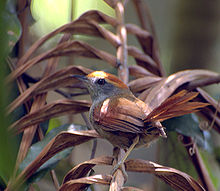




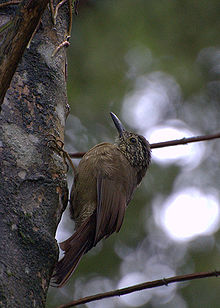
Order: Passeriformes Family: Furnariidae
Ovenbirds comprise a large family of small sub-oscine passerine bird species found in Central and South America. They are a diverse group of insectivores which gets its name from the elaborate "oven-like" clay nests built by some species, although others build stick nests or nest in tunnels or clefts in rock. The woodcreepers are brownish birds which maintain an upright vertical posture, supported by their stiff tail vanes. They feed mainly on insects taken from tree trunks.
- South American leaftosser, Sclerurus obscurior
- Short-billed leaftosser, Sclerurus rufigularis
- Black-tailed leaftosser, Sclerurus caudacutus
- Gray-throated leaftosser, Sclerurus albigularis
- Rufous-breasted leaftosser, Sclerurus scansor
- Common miner, Geositta cunicularia
- Campo miner, Geositta poeciloptera (near-threatened)
- Spot-throated woodcreeper, Certhiasomus stictolaemus
- Olivaceous woodcreeper, Sittasomus griseicapillus
- Long-tailed woodcreeper, Deconychura longicauda
- White-chinned woodcreeper, Dendrocincla merula
- Plain-brown woodcreeper, Dendrocincla fuliginosa
- Plain-winged woodcreeper, Dendrocincla turdina
- Wedge-billed woodcreeper, Glyphorynchus spirurus
- Cinnamon-throated woodcreeper, Dendrexetastes rufigula
- Long-billed woodcreeper, Nasica longirostris
- Amazonian barred-woodcreeper, Dendrocolaptes certhia
- Black-banded woodcreeper, Dendrocolaptes picumnus
- Hoffmanns's woodcreeper, Dendrocolaptes hoffmannsi (E)
- Planalto woodcreeper, Dendrocolaptes platyrostris
- Bar-bellied woodcreeper, Hylexetastes stresemanni
- Red-billed woodcreeper, Hylexetastes perrotii
- Uniform woodcreeper, Hylexetastes uniformis
- Strong-billed woodcreeper, Xiphocolaptes promeropirhynchus
- Moustached woodcreeper, Xiphocolaptes falcirostris (E) (vulnerable)
- White-throated woodcreeper, Xiphocolaptes albicollis
- Great rufous woodcreeper, Xiphocolaptes major
- Striped woodcreeper, Xiphorhynchus obsoletus
- Ceara woodcreeper, Xiphorhynchus atlanticus (E)
- Lesser woodcreeper, Xiphorhynchus fuscus
- Chestnut-rumped woodcreeper, Xiphorhynchus pardalotus
- Ocellated woodcreeper, Xiphorhynchus ocellatus
- Elegant woodcreeper, Xiphorhynchus elegans
- Spix's woodcreeper, Xiphorhynchus spixii (E)
- Buff-throated woodcreeper, Xiphorhynchus guttatus
- Straight-billed woodcreeper, Dendroplex picus
- Zimmer's woodcreeper, Dendroplex kienerii
- Red-billed scythebill, Campylorhamphus trochilirostris
- Black-billed scythebill, Campylorhamphus falcularius
- Curve-billed scythebill, Campylorhamphus procurvoides
- Scimitar-billed woodcreeper, Drymornis bridgesii
- Streak-headed woodcreeper, Lepidocolaptes souleyetii
- Narrow-billed woodcreeper, Lepidocolaptes angustirostris
- Scaled woodcreeper, Lepidocolaptes squamatus (E)
- Scalloped woodcreeper, Lepidocolaptes falcinellus
- Duida woodcreeper, Lepidocolaptes duidae
- Guianan woodcreeper, Lepidocolaptes albolineatus
- Inambari woodcreeper, Lepidocolaptes fatimalimae
- Dusky-capped woodcreeper, Lepidocolaptes fuscicapillus
- Slender-billed xenops, Xenops tenuirostris
- Plain xenops, Xenops minutus
- Streaked xenops, Xenops rutilans
- Point-tailed palmcreeper, Berlepschia rikeri
- Rufous-tailed xenops, Microxenops milleri
- Chaco earthcreeper, Tarphonomus certhioides (V)
- Wing-banded hornero, Furnarius figulus (E)
- Pale-legged hornero, Furnarius leucopus
- Pale-billed hornero, Furnarius torridus
- Lesser hornero, Furnarius minor
- Rufous hornero, Furnarius rufus
- Sharp-tailed streamcreeper, Lochmias nematura
- Wren-like rushbird, Phleocryptes melanops
- Curve-billed reedhaunter, Limnornis curvirostris
- Long-tailed cinclodes, Cinclodes pabsti (E)
- Buff-winged cinclodes, Cinclodes fuscus
- Dusky-cheeked foliage-gleaner, Anabazenops dorsalis
- White-collared foliage-gleaner, Anabazenops fuscus (E)
- Great xenops, Megaxenops parnaguae (E)
- Pale-browed treehunter, Cichlocolaptes leucophrus (E)
- Cryptic treehunter, Cichlocolaptes mazarbarnetti (E) (critically endangered) (First described in 2014. Not evaluated by the SACC; a proposal is pending. Not included in counts.)[9][10]
- Sharp-billed treehunter, Heliobletus contaminatus
- Rufous-rumped foliage-gleaner, Philydor erythrocercum
- Alagoas foliage-gleaner, Philydor novaesi (E) (extinct)
- Black-capped foliage-gleaner, Philydor atricapillus
- Cinnamon-rumped foliage-gleaner, Philydor pyrrhodes
- Rufous-tailed foliage-gleaner, Anabacerthia ruficaudata
- White-browed foliage-gleaner, Anabacerthia amaurotis (near-threatened)
- Ochre-breasted foliage-gleaner, Anabacerthia lichtensteini
- Buff-browed foliage-gleaner, Syndactyla rufosuperciliata
- Russet-mantled foliage-gleaner, Syndactyla dimidiata
- White-throated foliage-gleaner, Syndactyla roraimae
- Peruvian recurvebill, Syndactyla ucayalae (near-threatened)
- Chestnut-winged hookbill, Ancistrops strigilatus
- Buff-fronted foliage-gleaner, Dendroma rufa
- Chestnut-winged foliage-gleaner, Dendroma erythroptera
- Chestnut-capped foliage-gleaner, Clibanornis rectirostris
- Canebrake groundcreeper, Clibanornis dendrocolaptoides (near-threatened)
- Ruddy foliage-gleaner, Clibanornis rubiginosus
- Chestnut-crowned foliage-gleaner, Automolus rufipileatus
- Brown-rumped foliage-gleaner, Automolus melanopezus
- Buff-throated foliage-gleaner, Automolus ochrolaemus
- Striped woodhaunter, Automolus subulatus
- Olive-backed foliage-gleaner, Automolus infuscatus
- Para foliage-gleaner, Automolus paraensis (E)
- Pernambuco foliage-gleaner, Automolus lammi (E)
- White-eyed foliage-gleaner, Automolus leucophthalmus
- Tufted tit-spinetail, Leptasthenura platensis
- Striolated tit-spinetail, Leptasthenura striolata (E)
- Araucaria tit-spinetail, Leptasthenura setaria (near-threatened)
- Rufous-fronted thornbird, Phacellodomus rufifrons
- Little thornbird, Phacellodomus sibilatrix
- Freckle-breasted thornbird, Phacellodomus striaticollis
- Greater thornbird, Phacellodomus ruber
- Orange-eyed thornbird, Phacellodomus erythrophthalmus (E)
- Orange-breasted thornbird, Phacellodomus ferrugineigula
- Firewood-gatherer, Anumbius annumbi
- Lark-like brushrunner, Coryphistera alaudina
- Short-billed canastero, Asthenes baeri
- Cipo canastero, Asthenes luizae (E)
- Hudson's canastero, Asthenes hudsoni
- Itatiaia spinetail, Asthenes moreirae (E)
- Sharp-billed canastero, Asthenes pyrrholeuca (V)
- Pink-legged graveteiro, Acrobatornis fonsecai (E) (vulnerable)
- Orange-fronted plushcrown, Metopothrix aurantiaca
- Roraiman barbtail, Roraimia adusta
- Striated softtail, Thripophaga macroura (E) (vulnerable)
- Plain softtail, Thripophaga fusciceps
- Straight-billed reedhaunter, Limnoctites rectirostris (near-threatened)
- Sulphur-bearded reedhaunter, Limnoctites sulphuriferus
- Rusty-backed spinetail, Cranioleuca vulpina
- Parker's spinetail, Cranioleuca vulpecula
- Stripe-crowned spinetail, Cranioleuca pyrrhophia
- Olive spinetail, Cranioleuca obsoleta
- Pallid spinetail, Cranioleuca pallida (E)
- Gray-headed spinetail, Cranioleuca semicinerea (E)
- Tepui spinetail, Cranioleuca demissa
- Speckled spinetail, Cranioleuca gutturata
- Scaled spinetail, Cranioleuca muelleri (E)
- Bay-capped wren-spinetail, Spartonoica maluroides (near-threatened)
- Caatinga cacholote, Pseudoseisura cristata (E)
- Rufous cacholote, Pseudoseisura unirufa
- Brown cacholote, Pseudoseisura lophotes
- Yellow-chinned spinetail, Certhiaxis cinnamomeus
- Red-and-white spinetail, Certhiaxis mustelinus
- White-bellied spinetail, Mazaria propinqua
- Chotoy spinetail, Schoeniophylax phryganophilus
- Ochre-cheeked spinetail, Synallaxis scutata
- Gray-bellied spinetail, Synallaxis cinerascens
- Plain-crowned spinetail, Synallaxis gujanensis
- White-lored spinetail, Synallaxis albilora
- Red-shouldered spinetail, Synallaxis hellmayri (E)
- Rufous-capped spinetail, Synallaxis ruficapilla
- Bahia spinetail, Synallaxis cinerea (E) (near-threatened)
- Pinto's spinetail, Synallaxis infuscata (E) (endangered)
- McConnell's spinetail, Synallaxis macconnelli
- Cabanis's spinetail, Synallaxis cabanisi
- Cinereous-breasted spinetail, Synallaxis hypospodia
- Spix's spinetail, Synallaxis spixi
- Dark-breasted spinetail, Synallaxis albigularis
- Pale-breasted spinetail, Synallaxis albescens
- Sooty-fronted spinetail, Synallaxis frontalis
- Hoary-throated spinetail, Synallaxis kollari (critically endangered)
- Ruddy spinetail, Synallaxis rutilans
- Chestnut-throated spinetail, Synallaxis cherriei (near-threatened)
Manakins



Order: Passeriformes Family: Pipridae
The manakins are a family of subtropical and tropical mainland Central and South America, and Trinidad and Tobago. They are compact forest birds, the males typically being brightly colored, although the females of most species are duller and usually green-plumaged. Manakins feed on small fruits, berries and insects.
- Dwarf tyrant-manakin, Tyranneutes stolzmanni
- Tiny tyrant-manakin, Tyranneutes virescens
- Pale-bellied tyrant-manakin, Neopelma pallescens
- Saffron-crested tyrant-manakin, Neopelma chrysocephalum
- Wied's tyrant-manakin, Neopelma aurifrons (E)
- Serra do Mar tyrant-manakin, Neopelma chrysolophum (E)
- Sulphur-bellied tyrant-manakin, Neopelma sulphureiventer
- Araripe manakin, Antilophia bokermanni (E) (critically endangered)
- Helmeted manakin, Antilophia galeata
- Blue-backed manakin, Chiroxiphia pareola
- Swallow-tailed manakin, Chiroxiphia caudata
- Pin-tailed manakin, Ilicura militaris (E)
- White-throated manakin, Corapipo gutturalis
- Olive manakin, Xenopipo uniformis
- Black manakin, Xenopipo atronitens
- Blue-capped manakin, Lepidothrix coronata
- Snow-capped manakin, Lepidothrix nattereri
- Golden-crowned manakin, Lepidothrix vilasboasi (E) (vulnerable)
- Opal-crowned manakin, Lepidothrix iris (E)
- Orange-bellied manakin, Lepidothrix suavissima
- White-fronted manakin, Lepidothrix serena
- Orange-crowned manakin, Heterocercus aurantiivertex
- Yellow-crowned manakin, Heterocercus flavivertex
- Flame-crowned manakin, Heterocercus linteatus
- White-bearded manakin, Manacus manacus
- Crimson-hooded manakin, Pipra aureola
- Wire-tailed manakin, Pipra filicauda
- Band-tailed manakin, Pipra fasciicauda
- Striolated manakin, Machaeropterus striolatus
- Kinglet manakin, Machaeropterus regulus (E)
- Fiery-capped manakin, Machaeropterus pyrocephalus
- White-crowned manakin, Pseudopipra pipra
- Scarlet-horned manakin, Ceratopipra cornuta
- Golden-headed manakin, Ceratopipra erythrocephala
- Red-headed manakin, Ceratopipra rubrocapilla
- Round-tailed manakin, Ceratopipra chloromeros
Cotingas

Order: Passeriformes Family: Cotingidae
The cotingas are birds of forests or forest edges in tropical South America. Comparatively little is known about this diverse group, although all have broad bills with hooked tips, rounded wings, and strong legs. The males of many of the species are brightly colored or decorated with plumes or wattles.
- Hooded berryeater, Carpornis cucullatus (E) (near-threatened)
- Black-headed berryeater, Carpornis melanocephalus (E) (vulnerable)
- Red-banded fruiteater, Pipreola whitelyi
- White-tipped plantcutter, Phytotoma rutila (V)
- Swallow-tailed cotinga, Phibalura flavirostris (near-threatened)
- Guianan red-cotinga, Phoenicircus carnifex
- Black-necked red-cotinga, Phoenicircus nigricollis
- Guianan cock-of-the-rock, Rupicola rupicola
- Crimson fruitcrow, Haematoderus militaris
- Purple-throated fruitcrow, Querula purpurata
- Red-ruffed fruitcrow, Pyroderus scutatus
- Amazonian umbrellabird, Cephalopterus ornatus
- Capuchinbird, Perissocephalus tricolor
- Plum-throated cotinga, Cotinga maynana
- Purple-breasted cotinga, Cotinga cotinga
- Banded cotinga, Cotinga maculata (E) (endangered)
- Spangled cotinga, Cotinga cayana
- Rose-collared piha, Lipaugus streptophorus
- Screaming piha, Lipaugus vociferans
- Cinnamon-vented piha, Lipaugus lanioides (E) (near-threatened)
- Black-and-gold cotinga, Lipaugus ater (E) (near-threatened)
- Gray-winged cotinga, Lipaugus conditus (E) (vulnerable)
- White bellbird, Procnias alba
- Bearded bellbird, Procnias averano
- Bare-throated bellbird, Procnias nudicollis (vulnerable)
- Purple-throated cotinga, Porphyrolaema porphyrolaema
- Pompadour cotinga, Xipholena punicea
- White-tailed cotinga, Xipholena lamellipennis (E)
- White-winged cotinga, Xipholena atropurpurea (E) (vulnerable)
- Bare-necked fruitcrow, Gymnoderus foetidus
- Black-faced cotinga, Conioptilon mcilhennyi
Tityras

Order: Passeriformes Family: Tityridae
Tityridae are suboscine passerine birds found in forest and woodland in the Neotropics. The species in this family were formerly spread over the families Tyrannidae, Pipridae, and Cotingidae. They are small to medium-sized birds. They do not have the sophisticated vocal capabilities of the songbirds. Most, but not all, have plain coloring.
- Black-crowned tityra, Tityra inquisitor
- Black-tailed tityra, Tityra cayana
- Masked tityra, Tityra semifasciata
- Varzea schiffornis, Schiffornis major
- Olivaceous schiffornis, Schiffornis olivacea
- Brown-winged schiffornis, Schiffornis turdina
- Greenish schiffornis, Schiffornis virescens
- Cinereous mourner, Laniocera hypopyrra
- White-browed purpletuft, Iodopleura isabellae
- Dusky purpletuft, Iodopleura fusca
- Buff-throated purpletuft, Iodopleura pipra (E) (endangered)
- Shrike-like cotinga, Laniisoma elegans (near-threatened)
- White-naped xenopsaris, Xenopsaris albinucha
- Green-backed becard, Pachyramphus viridis
- Cinereous becard, Pachyramphus rufus
- Chestnut-crowned becard, Pachyramphus castaneus
- White-winged becard, Pachyramphus polychopterus
- Black-capped becard, Pachyramphus marginatus
- Glossy-backed becard, Pachyramphus surinamus
- Pink-throated becard, Pachyramphus minor
- Crested becard, Pachyramphus validus
Sharpbill
Order: Passeriformes Family: Oxyruncidae
The sharpbill is a small bird of dense forests in Central and South America. It feeds mostly on fruit but also eats insects.
- Sharpbill, Oxyruncus cristatus
Royal flycatchers
Order: Passeriformes Family: Onychorhynchidae
In 2019 the SACC determined that these five species, which were formerly considered tyrant flycatchers, belonged in their own family.
- Royal flycatcher, Onychorhynchus coronatus
- Ruddy-tailed flycatcher, Terenotriccus erythrurus
- Sulphur-rumped flycatcher, Myiobius barbatus
- Black-tailed flycatcher, Myiobius atricaudus
Tyrant flycatchers
Order: Passeriformes Family: Tyrannidae
Tyrant flycatchers are passerine birds which occur throughout North and South America. They superficially resemble the Old World flycatchers, but are more robust and have stronger bills. They do not have the sophisticated vocal capabilities of the songbirds. Most, but not all, have plain coloring. As the name implies, most are insectivorous.
- Wing-barred piprites, Piprites chloris
- Black-capped piprites, Piprites pileata
- Kinglet calyptura, Calyptura cristata (E)
- Cinnamon manakin-tyrant, Neopipo cinnamomea
- Cinnamon-crested spadebill, Platyrinchus saturatus
- White-throated spadebill, Platyrinchus mystaceus
- Golden-crowned spadebill, Platyrinchus coronatus
- White-crested spadebill, Platyrinchus platyrhynchos
- Russet-winged spadebill, Platyrinchus leucoryphus
- Ringed antpipit, Corythopis torquatus
- Southern antpipit, Corythopis delalandi
- Chapman's bristle-tyrant, Phylloscartes chapmani
- Southern bristle-tyrant, Phylloscartes eximius
- Mottle-cheeked tyrannulet, Phylloscartes ventralis
- Restinga tyrannulet, Phylloscartes kronei (E)
- Bahia tyrannulet, Phylloscartes beckeri (E)
- Olive-green tyrannulet, Phylloscartes virescens
- Black-fronted tyrannulet, Phylloscartes nigrifrons
- Alagoas tyrannulet, Phylloscartes ceciliae (E)
- Minas Gerais tyrannulet, Phylloscartes roquettei (E)
- São Paulo tyrannulet, Phylloscartes paulista
- Oustalet's tyrannulet, Phylloscartes oustaleti (E)
- Serra do Mar tyrannulet, Phylloscartes difficilis (E)
- Bay-ringed tyrannulet, Phylloscartes sylviolus
- Ochre-bellied flycatcher, Mionectes oleagineus
- McConnell's flycatcher, Mionectes macconnelli
- Sierra de Lema flycatcher, Mionectes roraimae
- Gray-hooded flycatcher, Mionectes rufiventris
- Sepia-capped flycatcher, Leptopogon amaurocephalus
- Black-chested tyrant, Taeniotriccus andrei
- Brownish twistwing, Cnipodectes subbrunneus
- Rufous twistwing, Cnipodectes superrufus
- Olivaceous flatbill, Rhynchocyclus olivaceus
- Yellow-olive flycatcher, Tolmomyias sulphurescens
- Yellow-margined flycatcher, Tolmomyias assimilis
- Gray-crowned flycatcher, Tolmomyias poliocephalus
- Yellow-breasted flycatcher, Tolmomyias flaviventris
- Eared pygmy-tyrant, Myiornis auricularis
- Short-tailed pygmy-tyrant, Myiornis ecaudatus
- Double-banded pygmy-tyrant, Lophotriccus vitiosus
- Long-crested pygmy-tyrant, Lophotriccus eulophotes
- Helmeted pygmy-tyrant, Lophotriccus galeatus
- Pale-eyed pygmy-tyrant, Atalotriccus pilaris
- Snethlage's tody-tyrant, Hemitriccus minor
- Acre tody-tyrant, Hemitriccus cohnhafti
- Flammulated pygmy-tyrant, Hemitriccus flammulatus
- Drab-breasted pygmy-tyrant, Hemitriccus diops
- Brown-breasted pygmy-tyrant, Hemitriccus obsoletus
- Boat-billed tody-tyrant, Hemitriccus josephinae
- White-eyed tody-tyrant, Hemitriccus zosterops
- White-bellied tody-tyrant, Hemitriccus griseipectus
- Eye-ringed tody-tyrant, Hemitriccus orbitatus (E)
- Johannes's tody-tyrant, Hemitriccus iohannis
- Stripe-necked tody-tyrant, Hemitriccus striaticollis
- Hangnest tody-tyrant, Hemitriccus nidipendulus (E)
- Pearly-vented tody-tyrant, Hemitriccus margaritaceiventer
- Pelzeln's tody-tyrant, Hemitriccus inornatus
- Zimmer's tody-tyrant, Hemitriccus minimus
- Buff-breasted tody-tyrant, Hemitriccus mirandae (E)
- Kaempfer's tody-tyrant, Hemitriccus kaempferi (E)
- Fork-tailed pygmy-tyrant, Hemitriccus furcatus (E)
- White-cheeked tody-flycatcher, Poecilotriccus albifacies
- Black-and-white tody-flycatcher, Poecilotriccus capitalis
- Buff-cheeked tody-flycatcher, Poecilotriccus senex (E)
- Ruddy tody-flycatcher, Poecilotriccus russatus
- Ochre-faced tody-flycatcher, Poecilotriccus plumbeiceps
- Smoky-fronted tody-flycatcher, Poecilotriccus fumifrons
- Rusty-fronted tody-flycatcher, Poecilotriccus latirostris
- Slate-headed tody-flycatcher, Poecilotriccus sylvia
- Spotted tody-flycatcher, Todirostrum maculatum
- Gray-headed tody-flycatcher, Todirostrum poliocephalum (E)
- Common tody-flycatcher, Todirostrum cinereum
- Painted tody-flycatcher, Todirostrum pictum
- Yellow-browed tody-flycatcher, Todirostrum chrysocrotaphum
- Cliff flycatcher, Hirundinea ferruginea
- Chico's tyrannulet, Zimmerius chicomendesi (E)
- Slender-footed tyrannulet, Zimmerius gracilipes
- Guianan tyrannulet, Zimmerius acer
- Lesser wagtail-tyrant, Stigmatura napensis
- Greater wagtail-tyrant, Stigmatura budytoides
- Plain tyrannulet, Inezia inornata
- Amazonian tyrannulet, Inezia subflava
- Pale-tipped tyrannulet, Inezia caudata
- Fulvous-crowned scrub-tyrant, Euscarthmus meloryphus
- Rufous-sided scrub-tyrant, Euscarthmus rufomarginatus
- White-lored tyrannulet, Ornithion inerme
- Southern beardless-tyrannulet, Camptostoma obsoletum
- Yellow-bellied elaenia, Elaenia flavogaster
- Large elaenia, Elaenia spectabilis
- Noronha elaenia, Elaenia ridleyana (E)
- White-crested elaenia, Elaenia albiceps
- Small-billed elaenia, Elaenia parvirostris
- Olivaceous elaenia, Elaenia mesoleuca
- Brownish elaenia, Elaenia pelzelni
- Plain-crested elaenia, Elaenia cristata
- Lesser elaenia, Elaenia chiriquensis
- Rufous-crowned elaenia, Elaenia ruficeps
- Tepui elaenia, Elaenia olivina
- Great elaenia, Elaenia dayi
- Small-headed elaenia, Elaenia sordida
- Yellow-crowned tyrannulet, Tyrannulus elatus
- Forest elaenia, Myiopagis gaimardii
- Gray elaenia, Myiopagis caniceps
- Yellow-crowned elaenia, Myiopagis flavivertex
- Greenish elaenia, Myiopagis viridicata
- Suiriri flycatcher, Suiriri suiriri
- Yellow tyrannulet, Capsiempis flaveola
- Rough-legged tyrannulet, Phyllomyias burmeisteri
- Greenish tyrannulet, Phyllomyias virescens
- Reiser's tyrannulet, Phyllomyias reiseri
- Yungas tyrannulet, Phyllomyias weedeni
- Planalto tyrannulet, Phyllomyias fasciatus
- Sooty-headed tyrannulet, Phyllomyias griseiceps
- Gray-capped tyrannulet, Phyllomyias griseocapilla (E)
- Mouse-colored tyrannulet, Phaeomyias murina
- White-throated tyrannulet, Mecocerculus leucophrys
- Bearded tachuri, Polystictus pectoralis
- Gray-backed tachuri, Polystictus superciliaris (E)
- Sharp-tailed tyrant, Culicivora caudacuta
- Crested doradito, Pseudocolopteryx sclateri
- Subtropical doradito, Pseudocolopteryx acutipennis
- Dinelli's doradito, Pseudocolopteryx dinelliana (H)
- Warbling doradito, Pseudocolopteryx flaviventris
- River tyrannulet, Serpophaga hypoleuca
- Sooty tyrannulet, Serpophaga nigricans
- White-crested tyrannulet, Serpophaga subcristata
- White-bellied tyrannulet, Serpophaga munda
- Straneck's tyrannulet, Serpophaga griseicapilla
- Rufous-tailed attila, Attila phoenicurus
- Cinnamon attila, Attila cinnamomeus
- Citron-bellied attila, Attila citriniventris
- Dull-capped attila, Attila bolivianus
- Gray-hooded attila, Attila rufus (E)
- Bright-rumped attila, Attila spadiceus
- Piratic flycatcher, Legatus leucophaius
- Large-headed flatbill, Ramphotrigon megacephalum
- Rufous-tailed flatbill, Ramphotrigon ruficauda
- Dusky-tailed flatbill, Ramphotrigon fuscicauda
- Great kiskadee, Pitangus sulphuratus
- Lesser kiskadee, Pitangus lictor
- Cattle tyrant, Machetornis rixosa
- Sulphury flycatcher, Tyrannopsis sulphurea
- Boat-billed flycatcher, Megarynchus pitangua
- Sulphur-bellied flycatcher, Myiodynastes luteiventris (V)
- Streaked flycatcher, Myiodynastes maculatus
- Rusty-margined flycatcher, Myiozetetes cayanensis
- Social flycatcher, Myiozetetes similis
- Gray-capped flycatcher, Myiozetetes granadensis
- Dusky-chested flycatcher, Myiozetetes luteiventris
- Yellow-throated flycatcher, Conopias parvus
- Three-striped flycatcher, Conopias trivirgatus
- Variegated flycatcher, Empidonomus varius
- Crowned slaty flycatcher, Empidonomus aurantioatrocristatus
- White-throated kingbird, Tyrannus albogularis
- Tropical kingbird, Tyrannus melancholicus
- Fork-tailed flycatcher, Tyrannus savana
- Eastern kingbird, Tyrannus tyrannus
- Gray kingbird, Tyrannus dominicensis (V)
- Grayish mourner, Rhytipterna simplex
- Pale-bellied mourner, Rhytipterna immunda
- Rufous casiornis, Casiornis rufus
- Ash-throated casiornis, Casiornis fuscus (E)
- White-rumped sirystes, Sirystes albocinereus
- Todd's sirystes, Sirystes subcanescens
- Sibilant sirystes, Sirystes sibilator
- Dusky-capped flycatcher, Myiarchus tuberculifer
- Swainson's flycatcher, Myiarchus swainsoni
- Short-crested flycatcher, Myiarchus ferox
- Brown-crested flycatcher, Myiarchus tyrannulus
- Long-tailed tyrant, Colonia colonus
- Roraiman flycatcher, Myiophobus roraimae
- Bran-colored flycatcher, Myiophobus fasciatus
- Chapada flycatcher, Guyramemua affinis
- Amazonian scrub-flycatcher, Sublegatus obscurior
- Southern scrub-flycatcher, Sublegatus modestus
- Vermilion flycatcher, Pyrocephalus rubinus
- Pied water-tyrant, Fluvicola pica
- Black-backed water-tyrant, Fluvicola albiventer
- Masked water-tyrant, Fluvicola nengeta
- White-headed marsh tyrant, Arundinicola leucocephala
- Streamer-tailed tyrant, Gubernetes yetapa
- Black-and-white monjita, Heteroxolmis dominicanus
- Cock-tailed tyrant, Alectrurus tricolor
- Strange-tailed tyrant, Alectrurus risora (V)
- Austral negrito, Lessonia rufa
- Spectacled tyrant, Hymenops perspicillatus
- Riverside tyrant, Knipolegus orenocensis
- Rufous-tailed tyrant, Knipolegus poecilurus
- Amazonian black-tyrant, Knipolegus poecilocercus
- Caatinga black-tyrant, Knipolegus franciscanus (E)
- Crested black-tyrant, Knipolegus lophotes
- Velvety black-tyrant, Knipolegus nigerrimus (E)
- Blue-billed black-tyrant, Knipolegus cyanirostris
- Cinereous tyrant, Knipolegus striaticeps (V)
- White-winged black-tyrant, Knipolegus aterrimus (V)
- Hudson's black-tyrant, Knipolegus hudsoni (V)
- Yellow-browed tyrant, Satrapa icterophrys
- Little ground-tyrant, Muscisaxicola fluviatilis
- Spot-billed ground-tyrant, Muscisaxicola maculirostris (V)
- Dark-faced ground-tyrant, Muscisaxicola maclovianus (V)
- Cinnamon-bellied ground-tyrant, Muscisaxicola capistratus (V)
- White-rumped monjita, Xolmis velatus
- White monjita, Xolmis irupero
- Gray monjita, Nengetus cinereus
- Black-crowned monjita, Neoxolmis coronatus
- Chocolate-vented tyrant, Neoxolmis rufiventris (V)
- Rusty-backed monjita, Neoxolmis rubetra (V)
- Gray-bellied shrike-tyrant, Agriornis micropterus (V)
- Lesser shrike-tyrant, Agriornis murinus (V)
- Drab water tyrant, Ochthornis littoralis
- Fuscous flycatcher, Cnemotriccus fuscatus
- Euler's flycatcher, Lathrotriccus euleri
- Alder flycatcher, Empidonax alnorum
- Olive-sided flycatcher, Contopus cooperi
- Smoke-colored pewee, Contopus fumigatus
- Western wood-pewee, Contopus sordidulus (V)
- Eastern wood-pewee, Contopus virens
- Tropical pewee, Contopus cinereus
- White-throated pewee, Contopus albogularis
- Blackish pewee, Contopus nigrescens
- Shear-tailed gray tyrant, Muscipipra vetula
- Many-colored rush tyrant, Tachuris rubrigastra
- Great kiskadee
- White-crested elaenia
- Common tody-flycatcher
- Gray-headed tody-flycatcher
- Cliff flycatcher
- Eastern wood-pewee
- Pied water-tyrant
- White-headed marsh tyrant
- Cattle tyrant
- Dusky-capped flycatcher
- Short-crested flycatcher
- Rusty-margined flycatcher
- Social flycatcher
- Piratic flycatcher
- Tropical kingbird
- Vermilion flycatcher
Vireos


Order: Passeriformes Family: Vireonidae
The vireos are a group of small to medium-sized passerine birds. They are typically greenish in color and resemble wood warblers apart from their heavier bills.
- Rufous-browed peppershrike, Cyclarhis gujanensis
- Gray-eyed greenlet, Hylophilus amaurocephalus (E)
- Rufous-crowned greenlet, Hylophilus poicilotis
- Ashy-headed greenlet, Hylophilus pectoralis
- Gray-chested greenlet, Hylophilus semicinereus
- Brown-headed greenlet, Hylophilus brunneiceps
- Lemon-chested greenlet, Hylophilus thoracicus
- Slaty-capped shrike-vireo, Vireolanius leucotis
- Tawny-crowned greenlet, Tunchiornis ochraceiceps
- Dusky-capped greenlet, Pachysylvia hypoxantha
- Buff-cheeked greenlet, Pachysylvia muscicapina
- Tepui vireo, Vireo sclateri
- Red-eyed vireo, Vireo olivaceus
- Chivi vireo, Vireo chivi
- Noronha vireo, Vireo gracilirostris (E) (near-threatened)
- Yellow-green vireo, Vireo flavoviridis
- Black-whiskered vireo, Vireo altiloquus
Jays
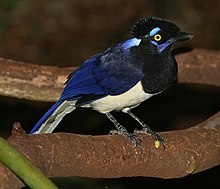
Order: Passeriformes Family: Corvidae
The family Corvidae includes crows, ravens, jays, choughs, magpies, treepies, nutcrackers, and ground jays. Corvids are above average in size among the Passeriformes, and some of the larger species show high levels of intelligence.
- Violaceous jay, Cyanocorax violaceus
- Purplish jay, Cyanocorax cyanomelas
- Azure jay, Cyanocorax caeruleus (near-threatened)
- Curl-crested jay, Cyanocorax cristatellus
- Cayenne jay, Cyanocorax cayanus
- Azure-naped jay, Cyanocorax heilprini
- Plush-crested jay, Cyanocorax chrysops
- White-naped jay, Cyanocorax cyanopogon (E)
Swallows


Order: Passeriformes Family: Hirundinidae
The family Hirundinidae is adapted to aerial feeding. They have a slender streamlined body, long pointed wings, and a short bill with a wide gape. The feet are adapted to perching rather than walking, and the front toes are partially joined at the base.
- Blue-and-white swallow, Pygochelidon cyanoleuca
- Black-collared swallow, Pygochelidon melanoleuca
- Tawny-headed swallow, Alopochelidon fucata
- White-banded swallow, Atticora fasciata
- White-thighed swallow, Atticora tibialis
- Southern rough-winged swallow, Stelgidopteryx ruficollis
- Brown-chested martin, Progne tapera
- Purple martin, Progne subis
- Caribbean martin, Progne dominicensis (V)
- Cuban martin, Progne cryptoleuca (V)
- Gray-breasted martin, Progne chalybea
- Southern martin, Progne elegans
- White-winged swallow, Tachycineta albiventer
- White-rumped swallow, Tachycineta leucorrhoa
- Chilean swallow, Tachycineta leucopyga
- Bank swallow, Riparia riparia
- Barn swallow, Hirundo rustica
- Cliff swallow, Petrochelidon pyrrhonota
Wrens

Order: Passeriformes Family: Troglodytidae
The wrens are mainly small and inconspicuous except for their loud songs. These birds have short wings and thin down-turned bills. Several species often hold their tails upright. All are insectivorous.
- Scaly-breasted wren, Microcerculus marginatus
- Flutist wren, Microcerculus ustulatus
- Wing-banded wren, Microcerculus bambla
- Tooth-billed wren, Odontorchilus cinereus
- House wren, Troglodytes aedon
- Tepui wren, Troglodytes rufulus
- Grass wren, Cistothorus platensis
- Bicolored wren, Campylorhynchus griseus
- Thrush-like wren, Campylorhynchus turdinus
- Moustached wren, Pheugopedius genibarbis
- Coraya wren, Pheugopedius coraya
- Buff-breasted wren, Cantorchilus leucotis
- Long-billed wren, Cantorchilus longirostris (E)
- Fawn-breasted wren, Cantorchilus guarayanus
- Gray wren, Cantorchilus griseus (E)
- White-breasted wood-wren, Henicorhina leucosticta
- Musician wren, Cyphorhinus aradus
Gnatcatchers
Order: Passeriformes Family: Polioptilidae
These dainty birds resemble Old World warblers in their build and habits, moving restlessly through the foliage seeking insects. The gnatcatchers and gnatwrens are mainly soft bluish gray in color and have the typical insectivore's long sharp bill. They are birds of fairly open woodland or scrub, which nest in bushes or trees.
- Collared gnatwren, Microbates collaris
- Trilling gnatwren, Ramphocaenus melanurus
- Chattering gnatwren, Ramphocaenus sticturus
- Tropical gnatcatcher, Polioptila plumbea
- Rio Negro gnatcatcher, Polioptila facilis
- Creamy-bellied gnatcatcher, Polioptila lactea (near-threatened)
- Guianan gnatcatcher, Polioptila guianensis
- Klages's gnatcatcher, Polioptila paraensis
- Inambari gnatcatcher, Polioptila attenboroughi (E)
- Masked gnatcatcher, Polioptila dumicola
Donacobius
Order: Passeriformes Family: Donacobiidae
The black-capped donacobius is found in wet habitats from Panama across northern South America and east of the Andes to Argentina and Paraguay.
- Black-capped donacobius Donacobius atricapilla
Thrushes

Order: Passeriformes Family: Turdidae
The thrushes are a group of passerine birds that occur mainly in the Old World. They are plump, soft plumaged, small to medium-sized insectivores or sometimes omnivores, often feeding on the ground. Many have attractive songs.
- Orange-billed nightingale-thrush, Catharus aurantiirostris
- Veery, Catharus fuscescens
- Gray-cheeked thrush, Catharus minimus
- Swainson's thrush, Catharus ustulatus
- Rufous-brown solitaire, Cichlopsis leucogenys
- Pale-eyed thrush, Turdus leucops
- Yellow-legged thrush, Turdus flavipes
- Pale-breasted thrush, Turdus leucomelas
- Cocoa thrush, Turdus fumigatus
- Hauxwell's thrush, Turdus hauxwelli
- Rufous-bellied thrush, Turdus rufiventris
- Spectacled thrush, Turdus nudigenis
- Varzea thrush, Turdus sanchezorum
- Lawrence's thrush, Turdus lawrencii
- Pantepui thrush, Turdus murinus
- Creamy-bellied thrush, Turdus amaurochalinus
- Black-billed thrush, Turdus ignobilis
- Campina thrush, Turdus arthuri
- Black-hooded thrush, Turdus olivater
- Blacksmith thrush, Turdus subalaris
- White-necked thrush, Turdus albicollis
Mockingbirds
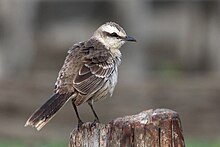
Order: Passeriformes Family: Mimidae
The mimids are a family of passerine birds that includes thrashers, mockingbirds, tremblers, and the New World catbirds. These birds are notable for their vocalizations, especially their ability to mimic a wide variety of birds and other sounds heard outdoors. Their coloring tends towards dull-grays and browns.
- Tropical mockingbird, Mimus gilvus
- Chalk-browed mockingbird, Mimus saturninus
- White-banded mockingbird, Mimus triurus
Starlings
Order: Passeriformes Family: Sturnidae
Starlings are small to medium-sized passerine birds. Their flight is strong and direct and they are very gregarious. Their preferred habitat is fairly open country. They eat insects and fruit. Plumage is typically dark with a metallic sheen.
- European starling, Sturnus vulgaris (I)
Estreldids

Order: Passeriformes Family: Estrildidae
The estrildid finches are small passerine birds of the Old World tropics and Australasia. They are gregarious and often colonial seed eaters with short thick but pointed bills. They are all similar in structure and habits, but have wide variation in plumage colours and patterns.
- Common waxbill, Estrilda astrild (I)
Old World sparrows
Order: Passeriformes Family: Passeridae
Old World sparrows are small passerine birds. In general, sparrows tend to be small, plump, brown or grey birds with short tails and short powerful beaks. Old World sparrow are seed eaters, but they also consume small insects.
- House sparrow, Passer domesticus (I)
Pipits and wagtails
Order: Passeriformes Family: Motacillidae
Motacillidae is a family of small passerine birds with medium to long tails. They include the wagtails, longclaws and pipits. They are slender, ground feeding insectivores of open country.
- Yellowish pipit, Anthus chii
- Short-billed pipit, Anthus furcatus
- Correndera pipit, Anthus correndera
- Ochre-breasted pipit, Anthus nattereri (vulnerable)
- Hellmayr's pipit, Anthus hellmayri
Finches

Order: Passeriformes Family: Fringillidae
Finches are seed-eating passerine birds, that are small to moderately large and have a strong beak, usually conical and in some species very large. All have twelve tail feathers and nine primaries. These birds have a bouncing flight with alternating bouts of flapping and gliding on closed wings, and most sing well.
- European greenfinch, Chloris chloris (H)
- European goldfinch, Carduelis carduelis, (I)
- Yellow-faced siskin, Spinus yarrellii (E) (vulnerable)
- Hooded siskin, Spinus magellanicus
- Golden-rumped euphonia, Chlorophonia cyanocephala
- Blue-naped chlorophonia, Chlorophonia cyanea
- Plumbeous euphonia, Euphonia plumbea
- Purple-throated euphonia, Euphonia chlorotica
- Finsch's euphonia, Euphonia finschi
- Golden-bellied euphonia, Euphonia chrysopasta
- White-vented euphonia, Euphonia minuta
- Green-throated euphonia, Euphonia chalybea (near-threatened)
- Violaceous euphonia, Euphonia violacea
- Thick-billed euphonia, Euphonia laniirostris
- Orange-bellied euphonia, Euphonia xanthogaster
- Golden-sided euphonia, Euphonia cayennensis
- Rufous-bellied euphonia, Euphonia rufiventris
- Chestnut-bellied euphonia, Euphonia pectoralis
Sparrows

Order: Passeriformes Family: Passerellidae
Most of the species are known as sparrows, but these birds are not closely related to the Old World sparrows which are in the family Passeridae. Many of these have distinctive head patterns.
- Grassland sparrow, Ammodramus humeralis
- Yellow-browed sparrow, Ammodramus aurifrons
- Black-striped sparrow, Arremonops conirostris
- Pectoral sparrow, Arremon taciturnus
- São Francisco sparrow, Arremon franciscanus (E)
- Half-collared sparrow, Arremon semitorquatus (E)
- Saffron-billed sparrow, Arremon flavirostris
- Rufous-collared sparrow, Zonotrichia capensis
- Tepui brushfinch, Atlapetes personatus
Blackbirds
Order: Passeriformes Family: Icteridae
The icterids are a group of small to medium-sized, often colorful, passerine birds restricted to the New World and include the grackles, New World blackbirds and New World orioles. Most species have black as the predominant plumage color, often enlivened by yellow, orange, or red.
- Bobolink, Dolichonyx oryzivorus
- Eastern meadowlark, Sturnella magna
- Red-breasted meadowlark, Leistes militaris
- White-browed meadowlark, Leistes superciliaris
- Pampas meadowlark, Leistes defilippii (V) (vulnerable)
- Russet-backed oropendola, Psarocolius angustifrons
- Green oropendola, Psarocolius viridis
- Crested oropendola, Psarocolius decumanus
- Olive oropendola, Psarocolius bifasciatus
- Solitary black cacique, Cacicus solitarius
- Golden-winged cacique, Cacicus chrysopterus
- Selva cacique, Cacicus koepckeae
- Yellow-rumped cacique, Cacicus cela
- Band-tailed cacique, Cacicus latirostris
- Red-rumped cacique, Cacicus haemorrhous
- Casqued cacique, Cacicus oseryi
- Orange-backed troupial, Icterus croconotus
- Campo troupial, Icterus jamacaii (E)
- Epaulet oriole, Icterus cayanensis
- Variable oriole, Icterus pyrrhopterus
- Baltimore oriole, Icterus galbula (V)
- Yellow oriole, Icterus nigrogularis
- Screaming cowbird, Molothrus rufoaxillaris
- Giant cowbird, Molothrus oryzivorus
- Shiny cowbird, Molothrus bonariensis
- Carib grackle, Quiscalus lugubris
- Velvet-fronted grackle, Lampropsar tanagrinus
- Oriole blackbird, Gymnomystax mexicanus
- Golden-tufted grackle, Macroagelaius imthurni
- Scarlet-headed blackbird, Amblyramphus holosericeus
- Forbes's blackbird, Anumara forbesi (E) (endangered)
- Chopi blackbird, Gnorimopsar chopi
- Grayish baywing, Agelaioides badius
- Pale baywing, Agelaioides fringillarius (E)
- Unicolored blackbird, Agelasticus cyanopus
- Yellow-winged blackbird, Agelasticus thilius
- Chestnut-capped blackbird, Chrysomus ruficapillus
- Yellow-hooded blackbird, Chrysomus icterocephalus
- Saffron-cowled blackbird, Xanthopsar flavus (vulnerable)
- Yellow-rumped marshbird, Pseudoleistes guirahuro
- Brown-and-yellow marshbird, Pseudoleistes virescens
- Bobolink
- White-browed meadowlark
- Shiny cowbird
- Scarlet-headed blackbird
- Orange-backed troupial
Wood-warblers


Order: Passeriformes Family: Parulidae
The wood-warblers are a group of small, often colorful, passerine birds restricted to the New World. Most are arboreal, but some are terrestrial. Most members of this family are insectivores.
- Northern waterthrush, Parkesia noveboracensis (V)
- Louisiana waterthrush, Parkesia motacilla (V)
- Black-and-white warbler, Mniotilta varia (V)
- Prothonotary warbler, Protonotaria citrea (H)
- Tennessee warbler, Leiothlypis peregrina (V)
- Connecticut warbler, Oporornis agilis (V)
- Masked yellowthroat, Geothlypis aequinoctialis
- American redstart, Setophaga ruticilla (V)
- Cerulean warbler, Setophaga cerulea (V)
- Tropical parula, Setophaga pitiayumi
- Blackburnian warbler, Setophaga fusca
- Yellow warbler, Setophaga petechia
- Blackpoll warbler, Setophaga striata
- Black-throated green warbler, Setophaga virens (V)
- White-striped warbler, Myiothlypis leucophrys (E)
- Flavescent warbler, Myiothlypis flaveolus
- White-browed warbler, Myiothlypis leucoblephara
- Buff-rumped warbler, Myiothlypis fulvicauda
- Riverbank warbler, Myiothlypis rivularis
- Two-banded warbler, Myiothlypis bivittatus
- Golden-crowned warbler, Basileuterus culicivorus
- Canada warbler, Cardellina canadensis (H)
- Slate-throated redstart, Myioborus miniatus
- Tepui redstart, Myioborus castaneocapillus
Mitrospingids
Order: Passeriformes Family: Mitrospingidae
Until 2017 the four species in this family were included in the family Thraupidae, the "true" tanagers.
- Olive-backed tanager, Mitrospingus oleagineus
- Red-billed pied tanager, Lamprospiza melanoleuca
- Olive-green tanager, Orthogonys chloricterus (E)
Cardinal grosbeaks
Order: Passeriformes Family: Cardinalidae
The cardinals are a family of robust, seed-eating birds with strong bills. They are typically associated with open woodland. The sexes usually have distinct plumages.
- Hepatic tanager, Piranga flava
- Summer tanager, Piranga rubra
- Scarlet tanager, Piranga olivacea
- White-winged tanager, Piranga leucoptera
- Red-crowned ant-tanager, Habia rubica
- Black-backed grosbeak, Pheucticus aureoventris (V)
- Rose-breasted grosbeak, Pheucticus ludovicianus (V)
- Rose-breasted chat, Granatellus pelzelni
- Yellow-green grosbeak, Caryothraustes canadensis
- Red-and-black grosbeak, Periporphyrus erythromelas
- Blackish-blue seedeater, Amaurospiza moesta
- Glaucous-blue grosbeak, Cyanoloxia glaucocaerulea
- Amazonian grosbeak, Cyanoloxia rothschildii
- Ultramarine grosbeak, Cyanoloxia brissonii
- Dickcissel, Spiza americana (V)
Tanagers
Order: Passeriformes Family: Thraupidae
The tanagers are a large group of small to medium-sized passerine birds restricted to the New World, mainly in the tropics. Many species are brightly colored. As a family they are omnivorous, but individual species specialize in eating fruits, seeds, insects, or other types of food. Most have short, rounded wings.
- Blue-backed tanager, Cyanicterus cyanicterus
- Hooded tanager, Nemosia pileata
- Cherry-throated tanager, Nemosia rourei (E) (critically endangered)
- Scarlet-throated tanager, Compsothraupis loricata (E)
- Brown tanager, Orchesticus abeillei (E) (near-threatened)
- Yellow-shouldered grosbeak, Parkerthraustes humeralis
- Green honeycreeper, Chlorophanes spiza
- Guira tanager, Hemithraupis guira
- Rufous-headed tanager, Hemithraupis ruficapilla (E)
- Yellow-backed tanager, Hemithraupis flavicollis
- Bicolored conebill, Conirostrum bicolor
- Pearly-breasted conebill, Conirostrum margaritae
- Chestnut-vented conebill, Conirostrum speciosum
- Stripe-tailed yellow-finch, Sicalis citrina
- Orange-fronted yellow-finch, Sicalis columbiana
- Saffron finch, Sicalis flaveola
- Grassland yellow-finch, Sicalis luteola
- Mourning sierra finch, Rhopospina fruticeti (V)
- Blue finch, Rhopospina caerulescens
- Paramo seedeater, Catamenia homochroa
- Scaled flowerpiercer, Diglossa duidae
- Greater flowerpiercer, Diglossa major
- Uniform finch, Haplospiza unicolor
- Blue-black grassquit, Volatinia jacarina
- Black-and-white tanager, Conothraupis speculigera (near-threatened)
- Cone-billed tanager, Conothraupis mesoleuca (E) (endangered)
- Flame-crested tanager, Loriotus cristatus
- Yellow-crested tanager, Loriotus rufiventer
- White-shouldered tanager, Loriotus luctuosus
- Fulvous-crested tanager, Tachyphonus surinamus
- Ruby-crowned tanager, Tachyphonus coronatus
- White-lined tanager, Tachyphonus rufus
- Red-shouldered tanager, Tachyphonus phoenicius
- Gray-headed tanager, Eucometis penicillata
- Black-goggled tanager, Trichothraupis melanops
- Pileated finch, Coryphospingus pileatus
- Red-crested finch, Coryphospingus cucullatus
- Masked crimson tanager, Ramphocelus nigrogularis
- Silver-beaked tanager, Ramphocelus carbo
- Brazilian tanager, Ramphocelus bresilius (E)
- Fulvous shrike-tanager, Lanio fulvus
- White-winged shrike-tanager, Lanio versicolor
- Coal-crested finch, Charitospiza eucosma (near-threatened)
- Short-billed honeycreeper, Cyanerpes nitidus
- Purple honeycreeper, Cyanerpes caeruleus
- Red-legged honeycreeper, Cyanerpes cyaneus
- Swallow tanager, Tersina viridis
- White-bellied dacnis, Dacnis albiventris
- Black-faced dacnis, Dacnis lineata
- Yellow-bellied dacnis, Dacnis flaviventer
- Black-legged dacnis, Dacnis nigripes (E) (near-threatened)
- Blue dacnis, Dacnis cayana
- Lesson's seedeater, Sporophila bouvronides
- Lined seedeater, Sporophila lineola
- White-bellied seedeater, Sporophila leucoptera
- Chestnut-bellied seedeater, Sporophila castaneiventris
- Ruddy-breasted seedeater, Sporophila minuta
- Black-and-tawny seedeater, Sporophila nigrorufa
- Copper seedeater, Sporophila bouvreuil
- Pearly-bellied seedeater, Sporophila pileata
- Tawny-bellied seedeater, Sporophila hypoxantha
- Dark-throated seedeater, Sporophila ruficollis (near-threatened)
- Marsh seedeater, Sporophila palustris
- Rufous-rumped seedeater, Sporophila hypochroma (near-threatened)
- Chestnut seedeater, Sporophila cinnamomea
- Black-bellied seedeater, Sporophila melanogaster (E) (near-threatened)
- Chestnut-bellied seed-finch, Sporophila angolensis
- Great-billed seed-finch, Sporophila maximiliani
- Large-billed seed-finch, Sporophila crassirostris
- Gray seedeater, Sporophila intermedia
- Wing-barred seedeater, Sporophila americana
- White-naped seedeater, Sporophila fringilloides
- Black-and-white seedeater, Sporophila luctuosa (V)
- Yellow-bellied seedeater, Sporophila nigricollis
- Dubois's seedeater, Sporophila ardesiaca (E)
- Double-collared seedeater, Sporophila caerulescens
- Slate-colored seedeater, Sporophila schistacea
- Temminck's seedeater, Sporophila falcirostris (vulnerable)
- Buffy-fronted seedeater, Sporophila frontalis (E) (vulnerable)
- Plumbeous seedeater, Sporophila plumbea
- Tropeiro seedeater, Sporophila beltoni (E)
- Rusty-collared seedeater, Sporophila collaris
- White-throated seedeater, Sporophila albogularis (E)
- Many-colored chaco finch, Saltatricula multicolor (V)
- Black-throated saltator, Saltatricula atricollis
- Buff-throated saltator, Saltator maximus
- Olive-gray saltator, Saltator olivascens
- Bluish-gray saltator, Saltator coerulescens
- Green-winged saltator, Saltator similis
- Thick-billed saltator, Saltator maxillosus
- Golden-billed saltator, Saltator aurantiirostris
- Slate-colored grosbeak, Saltator grossus
- Black-throated grosbeak, Saltator fuliginosus
- Black-masked finch, Coryphaspiza melanotis (vulnerable)
- Great Pampa-finch, Embernagra platensis
- Pale-throated Pampa-finch, Embernagra longicauda (E)
- Wedge-tailed grass-finch, Emberizoides herbicola
- Lesser grass-finch, Emberizoides ypiranganus
- Bay-chested warbling finch, Castanozoster thoracicus (E)
- Black-and-rufous warbling finch, Poospiza nigrorufa
- Orange-headed tanager, Thlypopsis sordida
- Chestnut-headed tanager, Thlypopsis pyrrhocoma
- Buff-throated warbling finch, Microspingus lateralis (E)
- Gray-throated warbling finch, Microspingus cabanisi
- Black-capped warbling finch, Microspingus melanoleucus
- Cinereous warbling finch, Microspingus cinereus (E)
- White-rumped tanager, Cypsnagra hirundinacea
- Long-tailed reed finch, Donacospiza albifrons
- Bananaquit, Coereba flaveola
- Dull-colored grassquit, Asemospiza obscura
- Sooty grassquit, Asemospiza fuliginosa
- White-banded tanager, Neothraupis fasciata (near-threatened)
- Diuca finch, Diuca diuca (V)
- Yellow cardinal, Gubernatrix cristata (endangered)
- Red-crested cardinal, Paroaria coronata
- Red-cowled cardinal, Paroaria dominicana (E)
- Red-capped cardinal, Paroaria gularis
- Crimson-fronted cardinal, Paroaria baeri (E)
- Yellow-billed cardinal, Paroaria capitata
- Diademed tanager, Stephanophorus diadematus
- Black-faced tanager, Schistochlamys melanopis
- Cinnamon tanager, Schistochlamys ruficapillus (E)
- Magpie tanager, Cissopis leverianus
- Fawn-breasted tanager, Pipraeidea melanonota
- Blue-and-yellow tanager, Rauenia bonariensis
- Black-headed tanager, Stilpnia cyanoptera
- Black-backed tanager, Stilpnia peruviana (E) (vulnerable)
- Chestnut-backed tanager, Stilpnia preciosa
- Burnished-buff tanager, Stilpnia cayana
- Masked tanager, Stilpnia nigrocincta
- Blue-necked tanager, Stilpnia cyanicollis
- Turquoise tanager, Tangara mexicana
- Paradise tanager, Tangara chilensis
- Opal-rumped tanager, Tangara velia
- Opal-crowned tanager, Tangara callophrys
- Green-headed tanager, Tangara seledon
- Seven-colored tanager, Tangara fastuosa (E) (vulnerable)
- Red-necked tanager, Tangara cyanocephala (E)
- Brassy-breasted tanager, Tangara desmaresti (E)
- Gilt-edged tanager, Tangara cyanoventris (E)
- Bay-headed tanager, Tangara gyrola
- Green-and-gold tanager, Tangara schrankii
- Blue-gray tanager, Thraupis episcopus
- Sayaca tanager, Thraupis sayaca
- Azure-shouldered tanager, Thraupis cyanoptera (E) (near-threatened)
- Golden-chevroned tanager, Thraupis ornata (E)
- Palm tanager, Thraupis palmarum
- Dotted tanager, Ixothraupis varia
- Speckled tanager, Ixothraupis guttata
- Yellow-bellied tanager, Ixothraupis xanthogastra
- Spotted tanager, Ixothraupis punctata
- Gray-headed tanager
- Blue-black grassquit
- Double-collared seedeater
- Chestnut-bellied seed-finch
- Saffron finch
- Great pampa finch
- Plumbeous seedeater
- Red-capped cardinal
- Yellow-billed cardinal
Notes
- The SACC has split Nyctiprogne atifascia from Nyctiprogne leucopyga (Proposal 673) but has not assigned English names, so the proposal has not been implemented and the counts do not reflect the change.
- The SACC has split black-throated trogon into five species (Proposal 921) but has not assigned English names, so the proposal has not been implemented and the counts do not reflect the change.
References
- "15 new species of birds discovered in Brazil". Wildlife Extra News. Retrieved 30 June 2012.
- "Novas aves da Amazônia" (PDF) (in Portuguese). Pesquisa FAPESP. Retrieved 30 June 2012.
- Pacheco, José Fernando; Quevedo Agane, Carlos Eduardo (August 25, 2021). "Species lists of birds for South American countries and territories: Brazil". South American Classification Committee of the American Ornithological Society. Retrieved February 2, 2022.
- Remsen, J. V., Jr., J. I. Areta, E. Bonaccorso, S. Claramunt, A. Jaramillo, D. F. Lane, J. F. Pacheco, M. B. Robbins, F. G. Stiles, and K. J. Zimmer. Version 24 July 2022. Species Lists of Birds for South American Countries and Territories. https://www.museum.lsu.edu/~Remsen/SACCCountryLists.htm retrieved July 24, 2022
- Remsen, J. V., Jr., J. I. Areta, E. Bonaccorso, S. Claramunt, A. Jaramillo, D. F. Lane, J. F. Pacheco, M. B. Robbins, F. G. Stiles, and K. J. Zimmer. Version 24 July 2022. A classification of the bird species of South America. American Ornithological Society. https://www.museum.lsu.edu/~Remsen/SACCBaseline.htm retrieved July 24, 2022
- The IUCN Red List of Threatened Species. Version 2017-3. http://www.iucnredlist.org accessed 17 February 2018
- Scaldaferro Bonfa, Gabriel (2020). "Registro documentado de caimão-de-Allen Porphyrio alleni para o Brasil". Cotinga (in Portuguese). 42: 119–120.
- Collar, N., P. F. D. Boesman, and C. J. Sharpe (2020). Glaucous Macaw (Anodorhynchus glaucus), version 1.0. In Birds of the World (J. del Hoyo, A. Elliott, J. Sargatal, D. A. Christie, and E. de Juana, Editors). Cornell Lab of Ornithology, Ithaca, NY, USA. https://doi.org/10.2173/bow.glamac1.01
- New Bird Species Discovered in 2014
- http://www.museum.lsu.edu/~Remsen/SACCproproster.htm SACC Proposal Roster
See also
- Wildlife of Brazil
- Lists of birds by region
- List of amphibians of Brazil
- List of reptiles of Brazil
- List of mammals of Brazil
- List of macaws
- List of amazon parrots
- List of Aratinga parakeets
- WikiAves - website dedicated to the Brazilian community of birdwatchers
External links
- National and state bird lists of Brazil - World Institute for Conservation and Environment
Другой контент может иметь иную лицензию. Перед использованием материалов сайта WikiSort.org внимательно изучите правила лицензирования конкретных элементов наполнения сайта.
WikiSort.org - проект по пересортировке и дополнению контента Википедии









